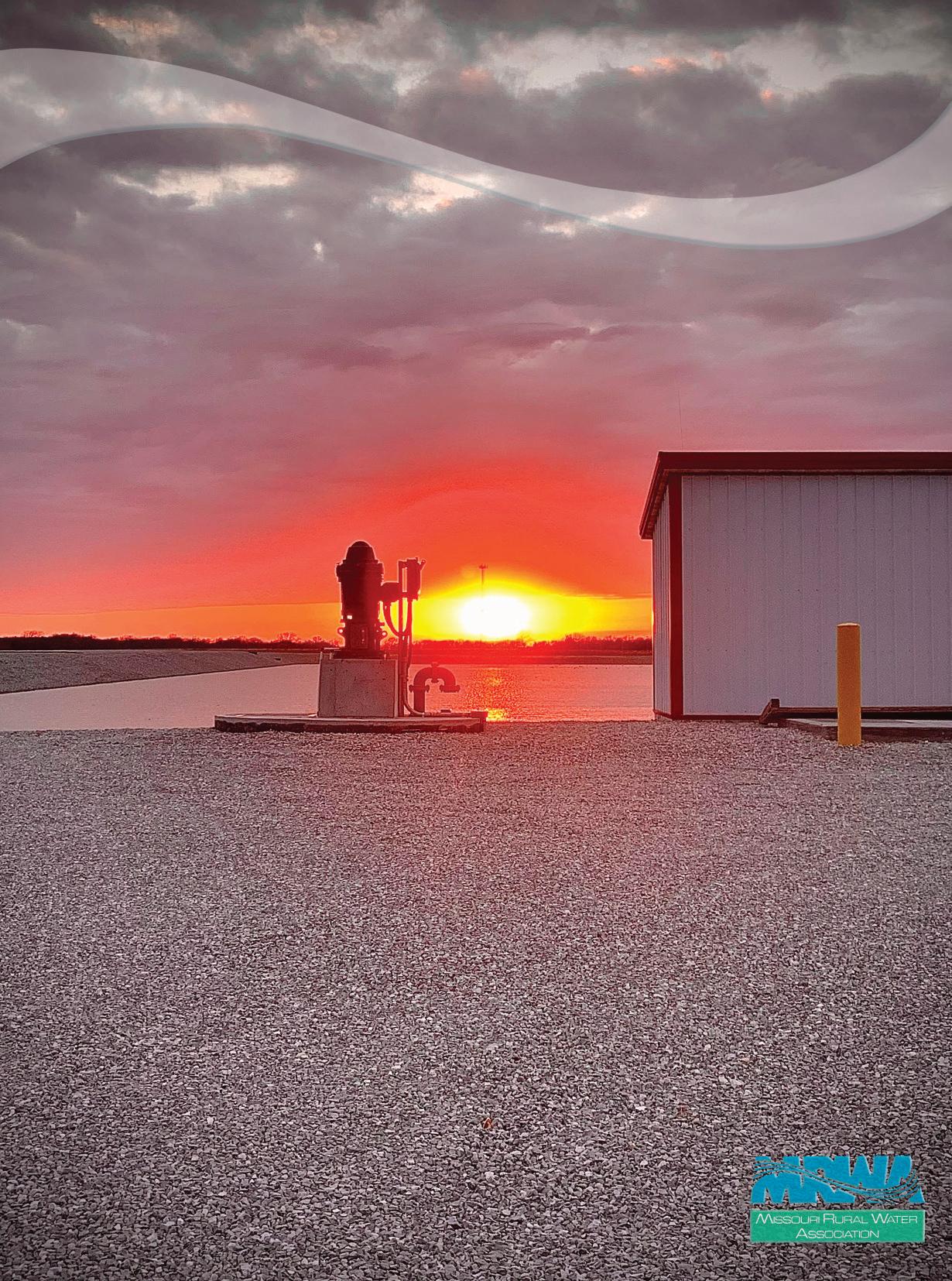
In this Issue: From the Executive Director ........................................................ 4 Recruiting Conscientious Employees ......................................... 10 Buffer Zones: Protecting Source Water Quality ........................ 14 Bundled Up Tight ....................................................................... 21 Mental Health: Peer-to-Peer Conversations .............................. 24 Importance of Training for Clerks and Board Members ............ 27 MRWA’s Newest Acronym - WQAS.......................................... 32 Water Meters: Cash Registers for the System ............................ 36 Love Your Lagoon! ...................................................................... 38 Faces of Rural Water ............................................................. 42-43 The Many Hats of a Small Town City Clerk .............................. 45 Apprenticeship Update ............................................................... 46 Little Otter Creek Reservoir: A 30 Year Rural Water Journey and Success Story ............. 50 Calendar of Events ...................................................................... 70 Affiliate, National Rural Water Association Winter 2023
PWSD No. 2 of Taney County, Missouri
$2,582,965 Waterworks Refunding Revenue Bonds
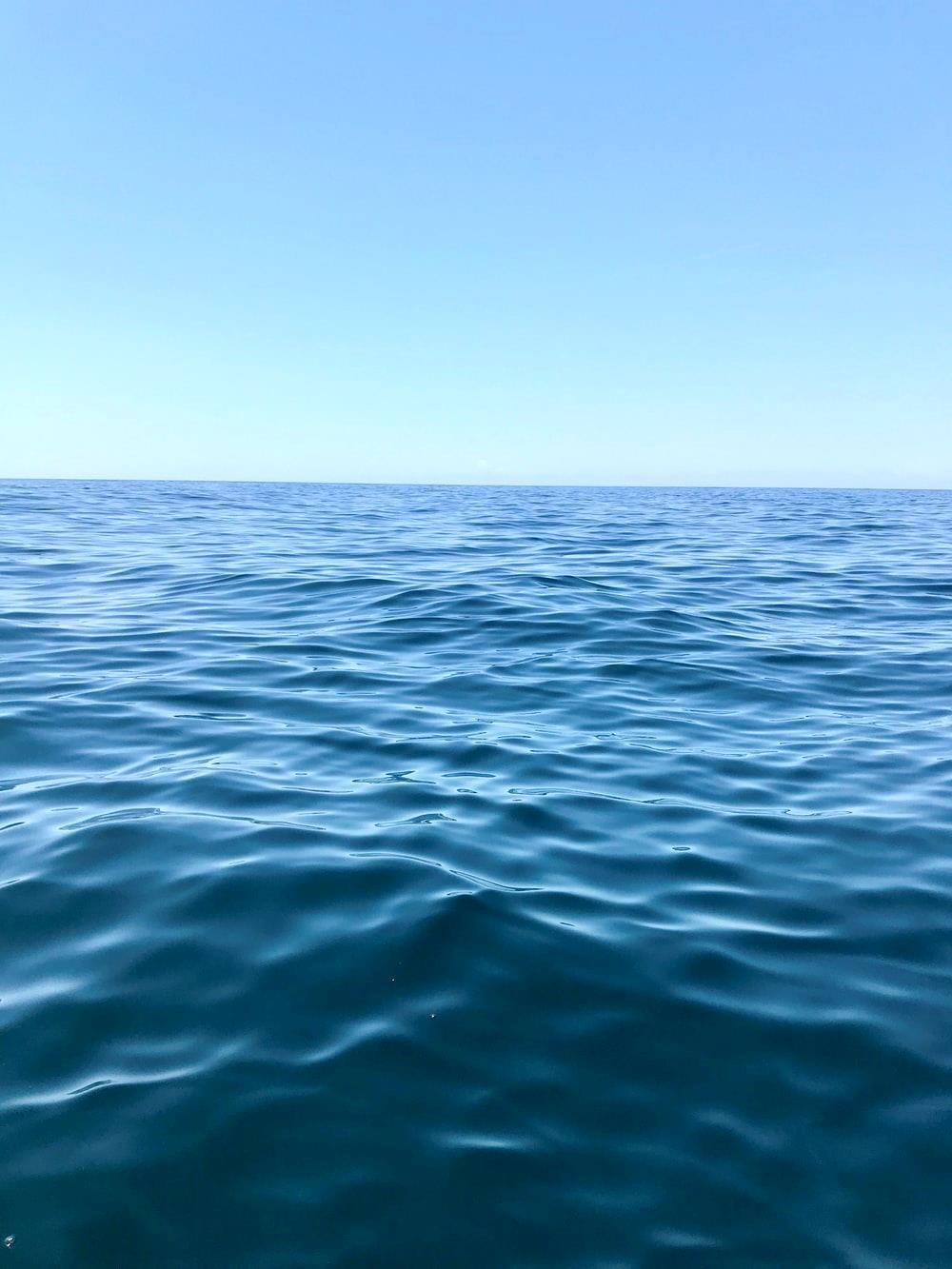
Proceeds were used to refund the District’s outstanding Series 2005A, 2006B & C, and 2007D Waterworks System Revenue Bonds

$2,103,963
Combined Waterworks and Sewerage System Refunding Revenue Bonds
Proceeds were used to refund the City’s Series 2004 Sewerage System Revenue Bonds and Series 2005 Combined Waterworks and Sewerage System Revenue Bonds


City of Walnut Grove, Missouri
$941,769
Combined Waterworks and Sewerage System Refunding Revenue Bonds

Proceeds were used to refund the City’s Series 2009A Combined Waterworks and Sewerage System Revenue Bonds

City of Cameron, Missouri
$6,270,000 Certificates of Participation
Proceeds were used to acquire Real Property, construct and equip a new community park, including the construction of three baseball fields, two soccer fields, trails/walkways, playground areas, and parking areas
Camelot Sewer District of Camden County, Missouri
$3,835,053 Sewerage System Refunding Revenue Bonds
Proceeds of the Bonds were used to pay and cancel the District’s outstanding USDA Loans
PWSD No. 10 of Cass County, Missouri
Proceeds were used to extend and improve the District’s
City of Louisiana, Missouri
Proceeds
$291,503
General Obligation Refunding Bonds
Proceeds from the Bonds were used to refund the City’s Taxable General Obligation Bonds (Build America Bonds – Direct Pay)
2
Go with who you know. D.A. Davidson & Co. – Providing service and solutions to Communities and Districts for over half a century.
$4,618,720 Certificates of Participation
Refunding
were used to refund the City’s Series 2015 and 2018 Certificates of Participation Caldwell County, Missouri $4,150,000
and Improvement Certificates of Participation
Proceeds were used in part to facilitate the construction of a dam and lake in the Little Otter Creek watershed as a storm water control, water supply and recreation project in the county
Waterworks System City of Cassville, Missouri $337,656 Combined Waterworks and Sewerage System Refunding Revenue Bonds Proceeds were used to refund the City’s Series 2018 Combined Waterworks and Sewerage System Revenue Bonds $448,176 Waterworks Refunding Revenue Bond Proceeds were used to refund the District’s outstanding Series 2012 Waterworks Refunding Revenue Bonds PWSD No. 8 of Clay County, Missouri City of Highlandville, Missouri City of Doniphan, Missouri $1,377,000 Waterworks System Revenue Bonds $6,000,000 Certificates of Participation Proceeds were used to construct a storage tower, two wells, a wellhouse, a booster pump station and a generator PWSD No. 3 of Taney County, Missouri Contact Jon Benson, Brock Goehl, Charlie Zitnik, or Steve Goehl at 1 -800-206-0634
MRWA Board of Directors
REGION I:
Roger Barker
Daviess County PWSD #3 116 Waterworks Drive Gallatin, MO 64640 (660) 663-2771 Fax: (660) 663-2771 rbarker@moruralwater.org
REGION II:
David Waller, President & National Director
Macon County PWSD #1 P.O. Box 386 Macon, MO 63552 (660) 651-3726 FAX: (660) 385-6006 dwaller@moruralwater.org
REGION III:
Tammie Winter C-PWSD #2 of Lafayette, Johnson And Saline Counties 1801 Walnut Street Higginsville, MO 64037 660/584-2344 Fax: 660-584-7650 twinter@moruralwater.org
REGION IV:
Janet Sears, Treasurer
Boone County C-PWSD #1 1500 N. 7th St. Columbia, MO 65201 (573) 449-0324 FAX: (573) 442-9222 jsears@moruralwater.org
Howard Baker
StaffExecutive Director
Crystal Cooper
Chief Financial Officer
Klark Bohling
Sourcewater Protection Specialist
Brandon Decker
Mapping Technician
Andy Bowman Marketing Coordinator
Maggie Dixon
Training Secretary
Billy Everett
Apprenticeship Coordinator
Liz Grove Management Circuit Rider
Tom Hyatt
Water Training Specialist
Donald Jones
Apprenticeship Trainer
Mark Klaus
EPA Water Training Specialist
Loyd Rawlings
EPA Waterwater Quality Specialist
Nathan Lines Water Circuit Rider
REGION V:
Kathy Voyles, Vice President
Jefferson County PWSD #8 7970 Graham Road, Box 170 Cedar Hill, MO 63016 (636) 274-3125
FAX: (636) 274-3126 kvoyles@moruralwater.org
REGION VI:
Melinda Piper, Secretary
Barton County C-PWSD #1 1009 E 11th St. PO Box 586 Lamar, MO 64759 (417) 682-3401 FAX: (417) 682-3038 mpiper@moruralwater.org
REGION VII:
Paul Michael Shaw
City of Caruthersville Municipal Building 200 W. 3rd St. Caruthersville, MO 63830 pmshaw@moruralwater.org
Contents
From the Executive Director ................................................ 4 Recruiting Conscientious Employees ................................. 10
Buffer Zones: Protecting Source Water Quality ................ 14 Bundled Up Tight ............................................................... 21
Mental Health: Peer-to-Peer Conversations ...................... 24 Importance of Training for Clerks and Board Members .... 27 MRWA’s Newest Acronym - WQAS.................................. 32 Water Meters: Cash Registers for the System .................... 36 Love Your Lagoon! .............................................................. 38 Faces of Rural Water ...................................................... 42-43 The Many Hats of a Small Town City Clerk ...................... 45 Apprenticeship Update ....................................................... 46
Little Otter Creek Reservoir: A 30 Year Rural Water Journey and Success Story ....... 50 Calendar of Events .............................................................. 70
Photo courtesy of Nathan Lines, MRWA Water Circuit Rider
Pictured: Lincoln, MO Wastewater Treatment Facility at sunset. The pumps pictured feed irrigation center pivots that land apply rather than having a discharge.
Remember . . .
Joe Anstine
Water Circuit Rider
Ami Dieckman
Water Circuit Rider
Brad Rayburn
Water Circuit Rider
Jim Patton
Small Systems Circuit Rider
Michael Bertschinger
Energy Efficiency Circuit Rider
Wayne Roderman
Resource Conservation Circuit Rider
Barry Barnes Wastewater Technician
Saem Yem
Member Services
Gary Webber
Wastewater Technician
Mary Calcagno
TMF Circuit Rider
Valarie Main TMF Circuit Rider
Call us and let us know your needs so we can stop and visit with you when we are in your area. There is no charge for our services. Call Missouri Rural Water Association at 573-657-5533.
Missouri Rural Water Association
Mission Statement:
“To be the leading source of professional services, support and representation for water and wastewater utilities.”
This Publication is Printed on Recycled Paper with Soybean Ink.
Missouri Water Lines is published by General Printing Service, 1910 N. Providence, Columbia, Missouri 65202, (573) 443-8890 and is distributed free to water/ wastewater systems, board presidents, mayors, suppliers, individual members and associate members. Call the MRWA office at (573) 657-5533 for copy deadlines. Subscription rates are $15.00 yearly to help cover printing and postage costs. To subscribe, send names and addresses with prepayment to: Missouri Rural Water Association, 901 Richardson Drive, Ashland, Missouri 65010.
3
From the Executive Director
Howard Baker, MRWA Executive Director

MRWA has been serving you for over 55 years. The funding received by MRWA from the US Department of Agriculture, US Environmental Protection Agency, and the Missouri Department of Natural Resources allows us to offer the assistance provided by our water, wastewater, source water, energy, and managerial staff. Each year, those 3 organizations must decide how, and where, to best spend their budgets, your tax money. There are many organizations vying for that limited amount of money, so every year we, MRWA, must share with our US Representatives and US Senators how MRWA uses those funds and how many systems are beneficially impacted in hopes that those elected officials can see how important the work is that MRWA does for you. Those of us in this industry know how important it is to keep the water flowing, but still, we must continue sharing the successes every year.
As the MRWA Executive Director, the most powerful tool I have to share with the powers that be, are your letters of appreciation. When you take the time to write a “thank you” letter, it really makes a big impact on me in how the MRWA staff are doing. But more importantly, those letters show just how important it is to keep those staff and programs in Missouri. When I have the opportunity to visit with our US elected officials about what MRWA does, nothing, and I do mean nothing, is as powerful as setting a big stack of your letters on their desk for them to read. And rest assured, they do read them because they are coming from people that vote.
As those of you who are assisted by MRWA staff already know, the MRWA staff are outstanding at what they do, but they have a hard time asking for those letters of appreciation. They know how important those letters are to continue their programs, but it is awkward for them to ask for a letter; for a system to write something good about how the MRWA staff assisted. It’s just not how they are built. I am sure that you have told them thanks for finding that leak, or helping with a plant problem, applying for a loan… well just about anything. I am asking you to go ahead and write that letter. They will appreciate it, and it’s a small way to do a big thing to ensure that MRWA will be here to serve you for the next 55 years.
(continued on page 8)
Mr. Baker,
Just a short note of appreciation for the work of Mr. Nathan Lines. Mr. Lines came by last week to check on and update the information on the Village of Ionia. While here, he asked to look over our water distribution site. I had expressed to him that I was experiencing a low level of chlorine in the system. It is injected into the system with a Stenner pump. Mr. Lines said he had just completed some training on the Stenner pump and would be glad to help find the problem.
He came this morning and was excellent in his work. He was very professional and complete in checking the injection site as well and repairing the Stenner pump. The entire procedure took about two hours. I have no reservation in commending Mr. Lines for his work.
Thanks to the Missouri Rural Water Association for hiring Mr. Nathan Lines!
William Smart, Mayor
Village of Ionia 104 West Fifth Street Ionia, Missouri 65335
4
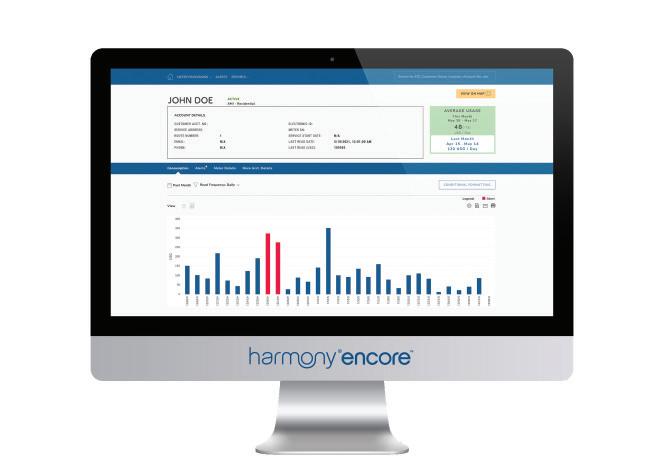

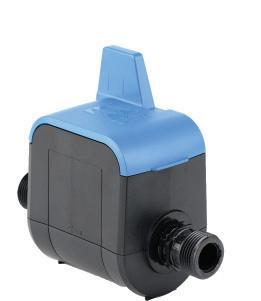
5 Got Water?
you do, you’re fortunate. We all forget that sometimes. Water must be managed so it’s there when we need it — whether for drinking, bathing, or activities vital to our local economies like agriculture and manufacturing.
why over 70 utility executives chose Master Meter as offering the “Best Smart Water Solution” at this year’s Smart Water Summit. Our tech portfolio helps utilities of all sizes manage water with precise measurement and intelligent software. Because Everyone Is A Water Manager™ Harmony® Encore™ Management Software Sonata Allegro™ Residential Ultrasonic with integrated AMI Neal Farmer | Vice President of Sales (817) 842-8000 | nfarmer@mastermeter.com mastermeter.com/gotwater/
If
See
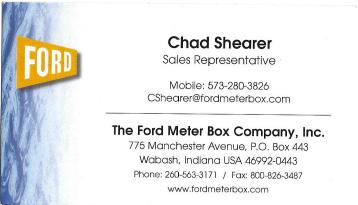
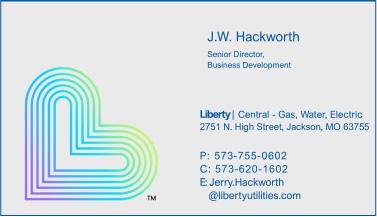
6 Advertisers Index We Appreciate Your Support ACE PIPE CLEANING INC ..................................................................... 20 ADVANCED MICROBIAL SOLUTIONS 31 ALLIANCE PUMP AND MECHANICAL ........................................... 29 ALLIANCE WATER RESOURCES INC............................................... 65 ALLSTATE CONSULTANTS LLC ........................................................ 67 ANDERSON ENGINEERING INC 17 BAKER MANUFACTURING CO LLC ................................................. 13 BARTLETT & WEST INC ......................................................................... 7 BROTCKE WELL & PUMP INC 17 C AND C PUMPS & SUPPLY 64 CADY AQUASTORE .................................................................................. 25 COCHRAN ................................................................................................... 53 COE EQUIPMENT 34 COGENT ....................................................................................................... 49 CORE & MAIN............................................................................................... 7 COURTMONEY .......................................................................................... 55 CUES INC 61 D A DAVIDSON & CO ...............................................................IFC & IBC DOUGLAS PUMP SERVICE ..................................................................... 7 ECC ELECTRIC CONTROLS COMPANY 53 EJ 37 EJ EQUIPMENT ............................................................................................ 7 ESI .................................................................................................................... 66 FLO-SYSTEMS INC 7 FLYNN DRILLING CO INC .................................................................... 54 FORD METER BOX CO .............................................................................. 6 HAWKINS INC ........................................................................................... 26 HAYNES EQUIPMENT CO 51 HF SCIENTIFIC .......................................................................................... 51 HOGANS INC ............................................................................................. 60 HYDRO-KINETICS CORP 38 IMCO UTILITY SUPPLY 37 KD JOHNSON INC.................................................................................... 44 KUBOTA TRACTOR CORP .................................................................... 19 KUPFERLE FOUNDRY CO 57 L & J MUNICIPAL SUPPLY...................................................................... 57 LAMP RYNEARSON ................................................................................. 55 LAYNE ............................................................................................................ 64 LIBERTY UTILITIES 6 MASTER METER INC ................................................................................ 5 MECO ENGINEERING CO INC ........................................................... 18 MELLEN & ASSOCIATES 22 MESSPLAY MACHINERY 33 METRON-FARNIER .................................................................................. 29 MICRO-COMM ........................................................................................... 62 MIDWEST COATING 12 MIDWEST INFRASTRUCTURE COATINGS ................................. 48 MIDWEST METER INC .......................................................................... 69 MIDWEST METER INC ................................................................ 53 & 57 MISSOURI LAGERS 17 MISSOURI OFFICE OF DENTAL HEALTH ..................................... 15 MISSOURI-AMERICAN WATER .......................................................... 35 MRWA CONFERENCES 57 MRWA E-NEWS BC MRWA SUBS ................................................................................................. 59 MSDI ............................................................................................................... 11 MUNICIPAL EQUIPMENT CO 64 NRWA FLEET PROGRAM ...................................................................... 35 NRWA MEMBERSHIP BENEFITS........................................................ 47 NRWA PRODUCTS AND SERVICES .................................................. 28 OZARK APPLICATORS LLC 68 PITTSBURG TANK...................................................................................... 9 R E PEDROTTI CO INC ........................................................................... 12 RESSLER & ASSOCIATES 17 RICHARDS ELECTRIC 38 RURAL WATER LOAN FUND USDA/NRWA................................. 23 RURALWATERIMPACT.COM................................................................ 63 SCHULTE SUPPLY INC 58 SEILER INSTRUMENT ............................................................................ 12 SIDENER ENVIRONMENTAL SERVICES ....................................... 53 SMICO CONTRACTING SERVICES LLC ......................................... 30 SMITH & CO 64 SPRINGFIELD WINWATER WORKS CO ......................................... 52 STL CONTRACTOR SERVICES LLC .................................................. 40 TANKSPEC CORP 33 T G RANKIN 64 THOUVENOT WADE & MOERCHEN INC .................................... 70 TOMCAT CONSULTANTS LLC – TAPCO ...................................... 62 TRAILER TRENDZ LLC 41 USDA WATER & WASTEWATER LOAN & GRANT PROGRAM 16 VEOLIA NORTH AMERICA formerly SUEZ 13 VIKING INDUSTRIAL PAINTING ..................................................... 30 ZENNER USA ............................................................................................. 37 Missouri Waterlines Advertising Rates BUSINESS ADS Members: Full page (7 ½ X 10) $550 per issue $900 Annually Half page (7 ½ X 4 ¾ ) $450 per issue $750 Annually Quarter Page (3 ½ X 4 ¾) $250 per issue $400 Annually Business Card (3 ½ X 2) $75 per issue $120 Annually Nonmembers: Full page $650 per issue Half page $500 per issue Quarter page $300 per issue Business card $100 per issue Cover Ads Back Cover – additional $200/issue Inside Front and Back Cover – additional $100/issue Contact MRWA Marketing Coordinator Andy Bowman with any further advertising questions (573) 657-5533 office (573) 714-3186 cell Email: abowman@moruralwater.org Support Missouri Rural Water Association Join Us as an Advertiser
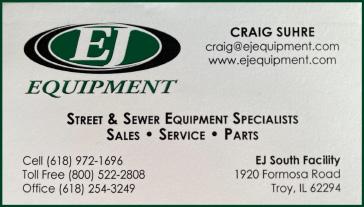




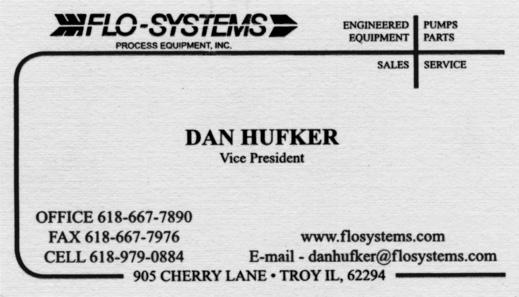
7
Dear Mr. Baker,
On behalf of the City of Brunswick, I wanted to convey my thanks to Mary West-Calcagno, Gary Webber, and Ami Dieckman, Missouri Rural Water staff members for the valuable support they have provided. I became Mayor April 12, 2022, without a history of city service. Our city clerk, all 3 city workers, and 2 of the 4 aldermen are new as well. We have had a lot of rebuilding to do.
That said, Gary happened to drop by my first day in office. He introduced me to Missouri Rural Water. I became interested in an engineering report grant and learned of the ARPA program. Then he gave me Mary West-Calcagno’s phone number. When we were having great difficulty with our sam.gov.access, Mary gave me a number for Ami. Each person has greatly helped our efforts.
Gary performed some basic field services with smoke testing our collection system and sludge judging our lagoon since we had no record of removal or evaluation in the last 15 years as well as guiding our new wastewater operator through EMD reporting. Mary came through Brunswick on her way home in May, pulled up our profile, and told me our wastewater permit was going to expire in September. With her help, I completed our new permit application and even went on to submit an ARPA project for consideration. Ami was amazing at troubleshooting our sam.gov.access. Our assistance from Mary and Gary has taught me much about our WW system. We are executing a study of our system as we speak.
Thanks for assembling such a great team that is willing to assist rural towns like ours!
Diane Rice, Mayor Brunswick, MO 65236
Dear Mr. Baker,
Today we had a visit from Mr. Wayne Roderman of the Missouri Rural Water Association. He patiently walked along our water lines here in the neighborhood, checking each connection and listening for running water (where it should not be). We suspected we had at least one leak that was causing us to use far more water each day than we should. He was very professional and thorough and fun to deal with.
We want to thank MRWA for being there and for helping us with that problem. We did confirm one leak and will be further checking on another and, also, now know that most of our lines are okay.
We appreciate the help and are pleased that such an organization exists.
The Kings River Water Board Scott Huckabee – President Chris Harlan – Vice President Dave Atkinson – Treasurer Cindy Thomovsky – Secretary Dave Juergens – Director
Dear Klark, Thank you for preparing the Sourcewater Protection Plan for the City of Martinsburg. I believe I had told you that our last DNR clean water inspection suggested we get this done. Thank you for completing this task for us to assist us with compliance with DNR.
The Council wishes to express their gratitude for your assistance. Per your suggestion, I have made a copy for our clean water superintendent. I will also make copies to share with the council members at our next meeting.
Sharon Welschmeyer City Clerk
8
(continued from page 4)
To Whom It May Concern,
I wanted to give a resounding SHOUT OUT and THANK YOU to Ami Dieckman Circuit Rider #4 Missouri Rural Water Association for all the support, visits and help she gave me with the ARPA Funds reporting that the Village of Glen Allen had to get accomplished.
Without her expertise and commitment to this small village, we would not be in compliance and would have never been able to accomplish the overwhelming task to comply.
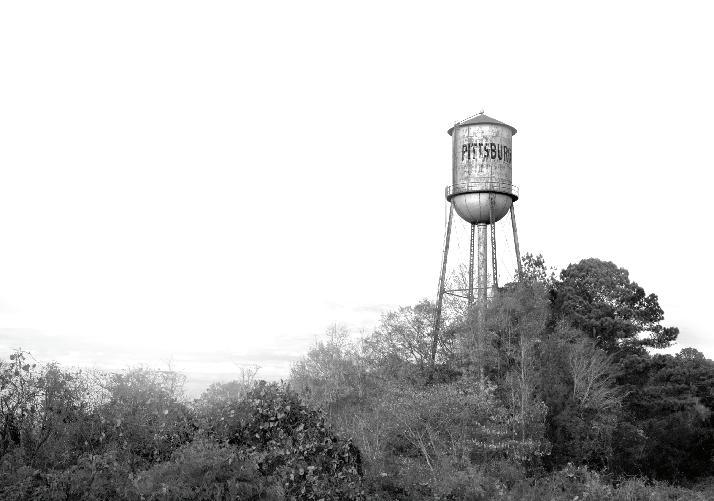
Ami made many visits to the Village of Glen Allen, and worked tirelessly to help me through the process (which by the way was awful). She kept in touch with me via email and phone calls even at the expense of her own personal time.
You have a wonderful employee in Ami and she deserves all the accolades for being professional, available and just downright one of the nicest people I have come into contact with.
MRWA is a fantastic resource for us and we truly want to thank you as an organization for hiring people like Ami and others who have helped us in so many ways and for being there for all of the systems you serve. Don’t know what we would do without you!
By the way, Ami deserves a big fat raise!!!
Carla Watt, Clerk Village of Glen Allen
Dear Brad,
Thank you for coming to Martinsburg to assist Brad Hoyt with the procedure for flushing the water lines. Mr. Hoyt reported to the City Council that you met with him to establish the order of procedure for the flushing exercise. He also said you were very knowledgeable and accommodating with your assistance.
The Council wishes to express their gratitude for your assistance. As you are aware, the flushing of lines has not occurred for a number of years. Now that Mr. Hoyt has directions to follow, he will be able to repeat the procedure again in six months and annually thereafter. Thank you for spending your time to give guidance for this project.
Sharon Welschmeyer
If you are interested in having us as your par tner, feel free to contact one of our depar tment representatives below NE W TANKS — Rick DiZinno ( 270) 826 -9000 ex t 2601 E X IS TING TANKS — Jordan Pyles ( 270) 826 -9000 ex t 4 601 Code Updates In-Service Cleaning
Recruiting Conscientious Employees
Tom Hyatt, MRWA Water Training Specialist


WANTED
Apply Within
We see these signs everywhere we go. It does not matter if the business is a convenience store, manufacturing company, specialized trade industry, or water utility. Every business needs dependable workers. The current ratio of available-jobs-to-willing-workers stands in stark contrast to my days as a young adult. Forty years ago, there were 50 or more applicants for every job; and you felt extremely lucky if you were selected for an interview. Usually, you had to apply for dozens of positions before you finally received a job offer.
Human resource specialists speculate upon ways to enhance recruitment and retention of workers. The typical remedies are increased starting wages, improved benefits, flexible work hours, collective management techniques in which every employee has a voice in decision-making, reasonable workloads, and various methods for employee engagement in the company mission.
To become more competitive, companies have raised starting pay and examined various incentives to entice would-be workers through their doors. Many water utilities have also re-evaluated pay scales and other benefits. Regardless of their best attempts, water utility managers share that they struggle to bring people into the industry. Even when individuals interview and receive a job offer, they don’t always show up to work. At other times, they work a day or more but then quickly determine that the work does not suit them. What are employers to do? How do they engage workers?
After pondering this question for years as both a workplace supervisor at my former water utility and as instructor in my 20th year of water training with Missouri Rural Water Association, I have a far different perspective from what I once held. Engagement is not the result of external incentives; it is a product of internal motivation.
Let me first extend a personal disclaimer: I am not arguing that employers have no responsibility to reevaluate what creates a fair work environment, such as just wages for job expectations. This is especially true in the water industry where the very health of the public is entrusted to the capable hands of workers; employees are subject to personal disruptions to sleep and time off, including holidays with family; and wages and benefits have historically remained subpar, even when comparing compensation rates with other labor-intensive professions.
On the other hand, I have witnessed financial incentives fail miserably in eliciting employee initiative. The external reward itself was insufficient to cause workers to jump into action or become attentive in doing work well.
If engagement or motivation is an internal quality unique to each individual, this leaves little control to utility managers. My conclusion is that managers cannot manufacture employee engagement. What managers can do, however, is observe those who exert work initiative, assert willingness to learn proper procedures, and complete tasks successfully. In other words, managers can identify employees who are already self-motivated and recruit these individuals to their utilities.
One way to accomplish this is for managers to attend water certification training. Besides earning renewal credit hours and receiving an all-things-water-utility refresher, managers can witness personal motivation in action. As an instructor, I can easily identify students who are
10
HELP
www.free-printable-signs.com
(continued on page 12)

11
self-driven to learn the material. Besides being earnest in wanting to pass their exams, these students want to learn because this is their field of work. They have questions about proper techniques for treatment of water or repair of water mains; and sometimes they have a particular challenge in their system and seek ways to resolve the issue. They strive to learn water math formulas and retain definitions of terminology.
I am reminded of the old phrase, “You can’t judge a book by its cover.” There are certainly hard-working individuals who are not academically inclined, who struggle with written material but who excel at hands-on, practical work assignments. These individuals might not always appear to be conscientious students, even though they can be trusted to perform heavy workloads and be available whenever a need arises. There are also people who are not verbally assertive and can appear inattentive in a classroom setting but are privately studying and doing well at retaining information. Generally, though, it is easy to see who is applying himself or herself in a classroom setting. This is especially true during daily quiz reviews and the final class review session. An observant manager might act upon this information to
offer job opportunities to these noteworthy performers. While financial incentives do not necessarily motivate an otherwise unmotivated worker to perform, they can appeal to those with internal drive as a prospective reward for hard work. If wanting to advance their careers or provide better wages and benefits to support their families, these individuals – the very people that any employer would like to recruit – might respond favorably to external rewards.


The challenge for all employers today is to fill vital roles at their businesses with employees who are willing to work. The assumption that a manager can instill a strong work ethic in individuals on the basis of pay, benefits, or other incentives seems futile. After all, too many jobs go unfilled, despite competitive advantages in diverse types of business settings. What a manager can do, instead, is observe those who already demonstrate initiative to learn and willingness to apply themselves. For these workers, financial considerations create real incentive, offering hard-working individuals opportunity for careers in water utilities where their initiative is truly compensated.



12
(continued from page 10) Scott Smith Mobile: (816) 518-7541 Office: (816) 331-3383 Email: ssmith@seilerinst.com www seilergeo com Sales * Rentals * Support * Repairs * Hardware * Software MIDWEST COATING CONSULTANTS, INC. DUSTIN KEILBEY 816-806-6356 dkeilbey@tnemec.com TAYLOR BUERKY 816-590-5294 tbuerky@tnemec.com MICHAEL CERUTTI 314-703-8042 mcerutti@tnemec.com COATING SOLUTIONS, LLC Independent Representatives of Tnemec Company, Inc. tnemec.com MRWA_3.5x2.indd 1 9/1/21 8:56 AM

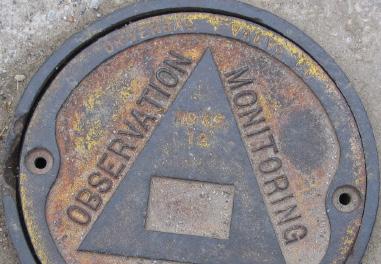
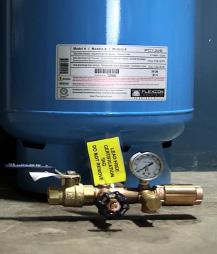
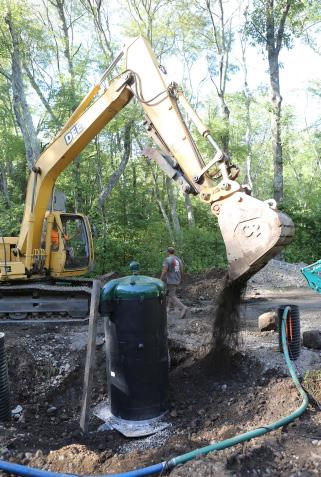
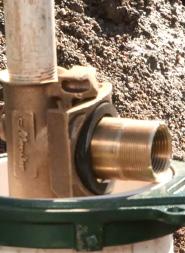
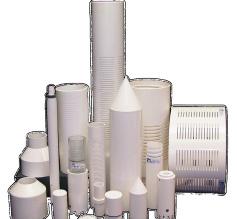


13 Asset management steel & concrete tanks | treatment plants | pipes | meters Water quality in distribution systems in-tank water mixers | trihalomethane removal systems disinfectant residual control systems Smart metering services Advanced Metering Infrastructure (AMI) smart meters | managed services | performance guarantees Contact your local water system consultant Tom Stechmann | 855-526-4413 | www.veolianorthamerica.com Global expertise delivered locally BAKER WATER SYSTEMS KNOWS GROUNDWATER DESIGNING AND MANUFACTURING WATER SYSTEM PRODUCTS IN THE U.S.A. 800-356-5130 | WWW.BAKERWATERSYSTEMS.COM MONITORSALES@BAKER-MFG.COM residential industrial municipal environmental
Buffer Zones: Protecting Source Water Quality

 Klark Bohling, Sourcewater Protection Specialist
Klark Bohling, Sourcewater Protection Specialist

One approach to the problem of reducing pollution from diffuse sources is the establishment of buffer zones. Buffer zones are vegetated areas of land which are separated from traditional farming and crops, managed separately from the rest of the field or catchment. These zones are used as barriers between the runoff of various agricultural pollutants and receiving waters, and are highly effective for the retention of nitrogen, phosphorus and pesticides. Some positive results research has shown from the use of these buffer zones includes the reduction of sediment, phosphorous, and nitrates from the runoff passing through these zones.

It has been accepted that vegetated buffer zones are effective in removing pollutants. The degree of effectiveness of buffer zones are grouped in three major categories according to the physical properties of the area regarding width, slope, vegetative cover and soil type.
They are:
1. Water Pollution hazard setback
2. Engineered Buffers
3. Vegetated Buffers
There are ways to create income from buffer zones. One of these is the Conservation Reserve Program which provides technical and financial assistance to eligible farmers to address soil, water, and related natural resource concerns. Additionally, there are funding opportunities for establishing pollinator habitat for bees and monarch butterflies. Much of the vegetation on which the bee and monarch butterfly thrive are the same assortment of varying plants that are perfect for buffer zones; it’s a win-win situation.

Vegetated buffer zones have proven to be an integral part of our state’s water quality and with their use, we can lower the cost of water treatment for human consumption, improve our lakes and streams for recreational use, and increase erosion prevention.
For more information on buffer zones or the Conservation Reserve Program, contact me at kbohling@moruralwater.org.
14






































































































































About the Program

This program provides funding for clean and reliable drinking water systems, sanitary sewage disposal, sanitary solid waste disposal, and storm water drainage to households and businesses in eligible rural areas.


Funding
Long-term, low-interest loan funding is available. If funds are available, a grant may be combined with a loan if necessary to keep user costs reasonable.

16 01 Drinking water sourcing, treatment, storage, and distribution 02 Sewer collection, transmission, treatment, and disposal 03 Solid waste collection, disposal, and closure 04 Storm water collection, transmission, and disposal 05 Other related activities such as permits and legal fees
WATER & WASTE WATER DISPOSAL LOAN AND GRANT PROGRAM USE YOUR FUNDS TO FINANCE THE ACQUISTION, CONSTRUCTION, OR IMPROVEMENT OF:
Scan the QR code to view more information and start your application.
USDA
Improve Your Facility
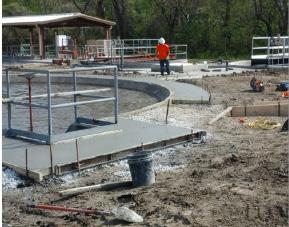

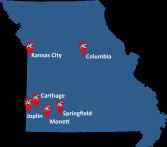


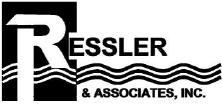
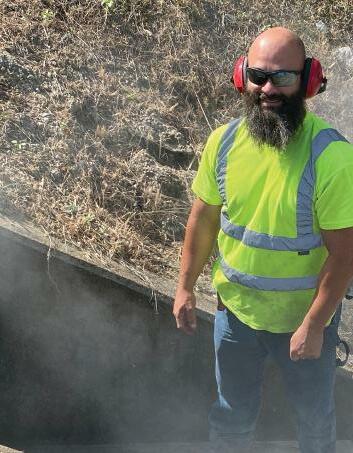


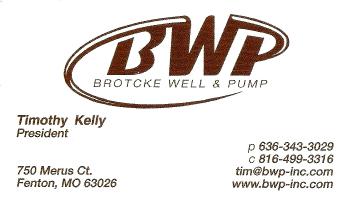
17 866-866-2741 ae-inc.com GIS • MAPPING • ENGINEERING REPORTS • FUNDING ASSISTANCE P.O. Box 4018, Ballwin, MO 63022-4018 (636) 391-8992 Fax: (636) 391-1544 sales@resslerassociates.com Engineered Process Equipment For Water, Wastewater & Industrial Waste Treatment; Spare Parts & Replacements Local Government Workers ALWAYS ESSENTIAL 800-447-4334 | molagers.org MISSOURI LAGERS Thank you to all public servants working to keep our communities safe and healthy.

18









19 (continued on page 14) KUB5527 - 2016 KAA MO Rural Water Program (KX/SVL/ZD/BX) - 7.5 x 10 kubota.com *For complete warranty, safety and product information, consult your local Kubota dealer and the product operator’s manual. Power (HP/KW) and other specifications are based on various standards or recommended practices. **Available on BX2370 and BX2670 models only. Kubota Tractor Corporation Markets a Full Line of Tractors and Construction Equipment Through a Nationwide Network of Over 1,000 Authorized Dealers. Optional equipment may be shown. © Kubota Tractor Corporation, 2016 KX040 — Standard Tail Swing Excavators • Turbocharged Kubota Diesel Engine — 40.4 HP* • Kubota Original ECO PLUS® Prioritizes Fuel Economy • Superior Cabin with A/C and Deluxe Suspension Seat Available SVL95-2 — Compact Track Loaders • Turbocharged Kubota Diesel Engine — 96.4 HP* • Standard 2-Speed Travel, Auxiliary Hydraulics & High Ground Clearance • Spacious Cab with Premium High-Back, Full-Suspension Seat BX Series — Sub-Compact Tractors • Powerful Kubota Diesel Engines — 18–25.5 HP* • Available Performance-Matched Attachments & Implements • New Easy-Over Mid-Mount Mower Deck** — Available in 54" or 60" Deck ZD1000 Series — Zero Turn Mowers • Powerful Kubota Diesel Engines — 19.3–21.6 HP* • All-New 48", 54" or 60" Kubota ProDeck with Aerodynamic Cutting System (ACS) • Up to 22% Improved Fuel Efficiency Equipment That Works for Your Community. Explore Kubota’s full line of quality mowers, tractors, utility vehicles, construction equipment and more. Visit www.MissouriKubotaDealers.com to find a dealer near you!
A Comprehensive Solution to Your Sewer System Maintenance Needs
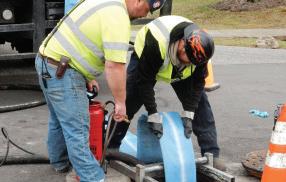


It doesn’t matter if your project calls for the use of one piece of equipment or multi-disciplinary crews and a fleet of specialized equipment. Ace Pipe Cleaning is uniquely positioned to work side-by-side with municipalities, utilities and industrial companies to deliver proven, scalable solutions.


Core Services:
• Multi Sensor Pipeline Inspection
• Sonar HD CCTV Pipeline Inspection
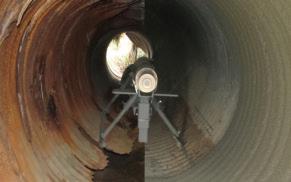
• Structural Rehab with Cement and Epoxy
• Spincast Cement Pipe Rehab
• CIPP Lateral Rehab
• Acoustic Pipe Inspection
6601 Universal Avenue
Kansas City, MO 64120 (800) 422-0815
4410 Hunt Avenue St. Louis, MO 63110 (314) 531-1127
www.acepipe.com
Bundled Up Tight
Michael Bertschinger, Energy Efficiency Circuit Rider


As the cooler temperatures of winter descend upon us, I am reminded of a young couple tackling life together. It was early winter, and they were excited to experience one of many firsts in their journey together, the purchase of their first home. It was a modest single wide trailer, but it was theirs, a place to call their own as they were looking at starting their family. This new journey allowed them to tackle new experiences and learn from them. One night during that first winter, the husband had been out pushing snow all night looking forward to coming home and going to sleep. The four days before he had been out each night de-icing and would spend the days repairing the equipment that had failed the nights before. This night had completed without incident and the upcoming sleep would be welcomed. Upon arriving home, he shed his winter gear and boots, trying to not wake her up. He went to the bathroom to wash his hands and no water flowed from the faucet! Following this was that sinking feeling, when you just know what is wrong. He made a quick phone call to borrow a salamander heater and dressed for the cold once again and started the process of thawing the pipes under the home. Luckily, it had been caught early enough and none of the piping had ruptured. My wife was incredibly grateful to have the ability to take a shower before she had to go to work that morning. (That’s right, this is my story.)
One of the things I learned from the incident was to step back and look at things that could have been prevented and their long-term cost. I could have set a salamander under the house for the rest of the winter and kept it running to be sure I would not have to deal with frozen pipes again. Figuring a salamander heater holds 4 gallons of fuel and runs for 12 hours on a tank, it would take 8 gallons to run 24 hours. Up until recent years, diesel was cheaper than kerosene,
but diesel is what we will use in this example at $5.00 per gallon. So, to run a salamander for 24hrs for 60 days to keep a pipe from freezing would cost (8 gallons X $5.00 X 60 Days) $2,400 for the winter. This would work but it would probably not be the best use of resources. A 25-foot-long heat tape using 7 Watts per foot, with electricity costs on average at $0.10 per KWh, running for the same amount of time would use (7 Watts X 25 Ft= 175 Watts. 175 Watts X 24 Hours X 60 Days) $2.52. I think we can all agree this is a better solution for this problem.
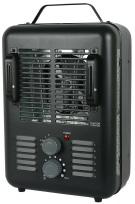
My point here is this; just because something works does not make it the only way to solve the problem. Running a milk house heater at full power for the winter should guarantee the plumbing inside your well house does not freeze, but is it the best use of your resources? The heater uses 1500 Watts of electricity per hour, 1500 Watts X 24 Hours X 30 days = 1,080,000 Watts or 1,080 KWh equaling $108.00 per month when the outside temperature is below 70 degrees, usually during November through March.
Consider keeping a lower temperature inside the building, I recommend starting at 50 degrees. The lower temperature inside the well house slows the heat transfer from inside the building to the outside and reduces the amount of time the heater needs to run. This can be done with plug in thermostats ($30-$60), I prefer the ones with the digital display. (They also have programmable ones so you can make sure the well house is toasty when you come by for samples if you like). If installing a thermostat reduces the time your heater runs by 25%, it will pay for itself in the first two months.
When you are looking at your well house for this winter and getting ready to plug in that heater into that new thermostat, step back and look at things around the building.
21 (continued on page 22)
Close the door, is there light coming in around the door anywhere? If so, then it is time to replace/install weatherstripping. This can be found from $0.30 to $0.65 per foot. The doorway, at 6’8” per side and 3’ across the top, will require about 16.2 feet to get the job done. If this will be a self-adhesive install, it would be best performed above 50 degrees. If the light is coming through at the bottom of the door, it is time to adjust/ replace the threshold. Check for adjustment screws for the threshold that allow it to be adjusted up or down or add a door sweep to the bottom of the door. Sweeps come in many styles, but they are all designed to slow or stop the air movement below the door. ($10.00). Another area to check is the door’s reveal, this is the spacing around the door, when it is closed, between the door and the jamb. This spacing should be consistent around the door to keep the door squared in the door jamb to prevent binding or dragging. If the reveal is not consistent it could require shimming the hinges or straightening bent hinges. Having a properly aligned reveal will help the weatherstripping and sweep do their jobs.

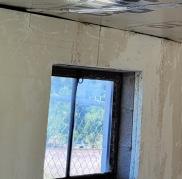
And…that vent fan in the wall or ceiling, do you have an uncomplicated way to cover it for the winter? Keep it simple, try 2” foam board ($0.60 per square foot) and duct tape to cover the opening. You can always remove it quickly if needed. If daylight can pass though so can air leading to heat leaching to the outside faster. What kind of insulation do you have for the walls and ceiling? If your well house is a block building, consider adding insulation to the inside face of the walls.
Without these small building improvements, your heater must work harder and longer to keep the temperature in your well house at 50 degrees (because you are using that new plug-in thermostat, right?) and the money you could be saving will continue to bleed off into the cold nights.


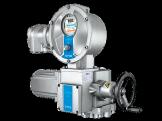


22 (continued from page 21)
EXPERIENCE Since 1962! EQUIPME Best in class! N e b r a s k a M i s s o u r i I o w a K a n s a s EXPERTISE Design & full service! www.melleninc.com IA & NE Office: 712-322-9333 MO & KS Office: 816-836-0202 T H E F L O W C O N T R O L S O L U T I O N S P R O V I D E R Serving
Loan
About The Program

The NRWA Rural Water Loan Fund (RWLF) is a funding program specifically designed to meet the unique needs of small water and wastewater utilities.



The RWLF provides low-cost loans for short-term repair costs, small capital projects, or pre-development costs associated with larger projects. The RWLF was established through a grant from the USDA/RUS, and repaid funds used to replenish the fund and make new loans.
The NRWA Rural Water Loan Fund (RWLF) is a funding program specifically designed to meet the unique needs of small water and wastewater utilities. The RWLF provides low-cost loans for short-term repair costs, small capital projects, or pre-development costs associated with larger projects. The RWLF was established through a grant from the USDA/RUS, and repaid funds used to replenish the fund and make new
National Rural Water Association is an equal opportunity provider and employer. This material is based upon work supported by the Rural Utilities Service, United States Department of Agriculture


Reasons to apply • Reasonable interest rates • NRWA does not charge administrative or processing fees • Straightforward application process • Quick turnaround
Projects Include • Pre-development (planning) costs for infrastructure projects • Replacement equipment, system upgrades, maintenance and small capital projects • Energy efficiency projects to lower costs and improve sustainability • Disaster recovery or other emergency loans available Contact your State Rural Water Association or National Rural Water Association for help with the application process.
loans.
Eligible
WATER
Fund RURAL
costs for infrastructure projects Replacement equipment,
projects Energy efficiency projects
Disaster recovery or
emergency loans available
Eligible Projects Pre-development (planning)
system upgrades, maintenance and small capital
to lower costs and improve sustainability
other
interest rates No administrative or processing fees Straightforward application process and quick turnaround
on applications
Reasons to Apply Reasonable
Systems must be public entities serving up to 10,000 persons, or in rural areas with no population limits Loan amounts may not exceed $200,000 or 75% of the total project cost, whichever is less Emergency loans are 90-day no interest, with immediate turn around
information and forms
Apply today by contacting your State Rural Water Association or NRWA! Applications,
can be downloaded from the NRWA website at nrwa.org or by scanning the QR Code above. For help, please call 1.800.332.8715 or email nrwarwlf@nrwa.org.
Mental Health: Peer-to-Peer Conversations
Nathan Lines, Drinking Water Circuit Rider

As operators you have an unlimited number of resources available to you to tackle almost every situation you come across. If you need to figure out your monthly water loss, you can go to your MRWA Tools App, punch in how many gallons of water you pumped and how much you sold, and just like that, you have a quick percentage of water loss without even breaking out the calculator. If your system has a water leak and you are not sure of the location of the leak, you can pick up the phone and call MRWA, and a circuit rider or other field staff will bring out advanced leak detection equipment and do everything in their power to pinpoint that leak, saving you time and money. But what do you do when there is a situation where there might not be an abundance of resources to help you with?
As you become operators, you go through training and classes and get a certificate that says you can operate a water/wastewater system. You are expected to know all the answers to everyone’s questions and concerns about your system or town. In most cases, if you work in a small town, you wear many hats. Not only are you the operator of the water or wastewater system, you are also responsible for the streets, and parks, and general maintenance of everything in your town. With all those hats comes stress and responsibility. This is the situation I talk about when I say there are not a lot of resources available to us. The mental health of operators is a topic that I have never seen a training class on. It was not discussed during my operator certification classes or in the manual when I studied and took my certification tests.
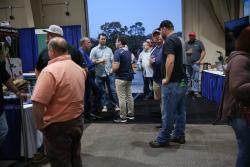
l would like to share a story about a situation that happened to me years ago as an operator. One summer morning in June during the heart of baseball season, I got my monthly shut-off list to disconnect unpaid customers, as I did every month. Now shutting off anyone at first is rough on you, but after a few months of doing it, you start to get used to it. But this month was different and the reason being is, as I started to do my shutoffs, I realized that one of the people on my list was a family
that had a boy on the baseball team that I coached. As I pulled up to the front yard, this little boy that thinks I am Superman or something great comes running out his front door and yells, “Hey Coach! What ya doing?” At that moment, my world got really small, and I had to tell this young man that I was turning off his water because it was part of my job, and I did not like doing it, but I had to. That young man did not understand and how could he? I had not done anything wrong, yet I felt so terrible. Later that afternoon at practice that normally happy cheerful young man was not himself. I knew he was confused and did not understand why I would have shut off his water. His parents glared at me as most people do that get their water shut off by you. In that moment, in that day, I was not proud to be an operator. I did not like my job and I did not like the way it made me feel.

Mental health of public works and water operators is a topic that does not receive much, if any, attention, but I know the struggle and the stress that these positions can force upon us. Most of the customer feedback you get is only the negative. Rarely does anyone seem happy with something you have done. It is a very thankless job. So, what do we do to fill the void where there are not a lot of resources available to help with these types of circumstances? If you are like me, most of the time you bottle it up and keep working because that is what we think we are supposed to do. But that does not work in the long term, so I strongly suggest you reach out to other operators.
Peer-to-peer conversations about these circumstances,
24
telling stories and reminiscing on the good and bad experiences you have had as an operator is a great way to “lighten” the burden while learning from others’ experiences. As you begin to talk to other operators, and you also listen to their stories and experiences, it will help with understanding your own. Peer-to-peer conversations can lead to so many good things. I have learned tricks and tips that other operators do that have helped me in the past. Things that I had not even thought of or knew existed, I learned from talking to another operator.
So how do we meet other peers? Well, the best place I know to do this is one of the MRWA Conferences. Operators from all over the state gather to learn about current topics going on in the water and wastewater industry. There are classes to fit a wide array of operations, vendors galore showing off all the newest and greatest products used in the industry, and best of all, there are operators from every size system and town that you can meet and talk to and learn from each other.


I conclude by sharing that I am a US Armed Forces veteran and mental health issues with co-workers, present and past, have made a significant impact on my life. If you need someone to talk to please reach out to family, friends, coworkers; anyone that will listen. It’s okay to ask for help.












25


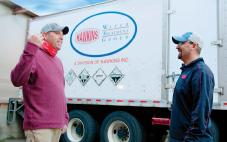
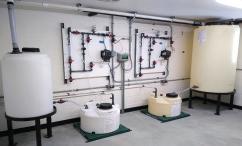

Water Treatment Chemicals, Equipment and Local Service WATER TREATMENT SERVICE EQUIPMENT Custom treatment designed specifically for your facility 800.328.5460 w w w. h a w k i n s i n c . c o m • e m a i l : w t g @ h a w k i n s i n c . c o m • Potable Water • Wastewater Treatment • Bioaugmentation Solutions • Collection Systems • Mini Bulk Delivery • Local Technical Support • Equipment Installations • Laboratory Testing • Chemical Injection Pumps • Control and Monitoring Systems • Chlorination Control Systems • Chemical Feed Equipment Columbia, MO 573 . 886.9500 Garnett, KS 785.448.1610 Fayetteville, TN 888.542.8561 Memphis, TN 9 01.7 74.12 9 9
Importance of Training for Clerks and Board Members
 Valarie Main, TMF Specialist
Valarie Main, TMF Specialist

The headline reads: “A former clerk of Silver City, Iowa was sentenced to 10 years in prison Monday after pleading guilty to first-degree theft.”
This is a headline that all too often overshadows small towns or water districts. We attend conferences and listen to the same song and dance at least 10 times a day while there with other clerks. Please don’t get me wrong, no story is word for word the same and everyone seems to have a different variation of what occurred during their predecessor’s time in office. After talking to cities, many times this type of crime goes unpunished or is handled internally with little to no consequences.
Is justice served if you spend additional city funds to the tune of thousands of dollars on legal teams to sort through and deal with the wrongdoing? Is it justice to slide it under the table and wash our hands of it because it will cost too much to prosecute? Even worse, is pursuing justice worth the trust we’ll lose from our residents/customers knowing that we had an issue with those employed to serve the community? Many cities have decided to just handle it quietly, so they don’t lose the trust of their residents.
As clerks, many of us feel it is our duty to protect our cities from harm and to protect our cities’ finances as if they were our own. A lot of us do exactly that. However, more and more we hear of employees that do not. This is the area extremely near and dear to my heart. What is the fix here? How do we protect our cities from being the victim? Furthermore, how do we protect the clerks who are accused of wrongdoing by small town gossip when they’ve done no wrong?
Small towns do not have a big surplus of money and that is the way it should be. I feel a city should be running a close budget with incoming and outgoing funds. The “extra” should be used to improve infrastructure and the town itself. After all, a city isn’t spending its money, it is spending the money of its residents. I have not found the fix-all solution, but here are a few suggestions that I think may help:
• Board and Council Training - This is the very first step. A lot of small systems have board members that do not collect a paycheck from the city or water district. The elected officials do not have the time to dedicate to understanding what it is they do or how important it is for them to stay alert to possible issues. Some don’t know how to spot possible issues. It is vital that decision-makers understand what is and what is not presented to them at the meetings. Financial statements have a lot to say about the city’s/district’s financial position. If decision-makers cannot discern the data given them in the financial statement, then they likely aren’t looking for issues. When your board becomes a “yes board” that is when things go astray.
• Clerk Training – I hear office personnel frequently say, “I am the only one in the office. We can’t just close so I can go to training,” or “we are a small system, we just can’t afford to go.” My response to this is always the same. YOU
27
(continued on page 28)
CAN’T AFFORD NOT TO! We all know that operators receive training and that it is budgeted because it is necessary for them to be certified for system compliance. But can we talk about the clerks? How many small system clerks do you know that have experience with governmental duties before being hired for the city or district? The clerk is, in most cases, the gate keeper to the city’s records and financial functions. Is that truly someone we do not want to send to training?
• Audits – Please don’t get me wrong, I know audits are expensive! I understand that it is hard to budget for things like this! However, if you don’t have a board of alderman that are accountants looking through the financial documents being submitted to them (or if you aren’t getting financial statements at all presented to your board) this is a GREAT way to discover discrepancies.
• Insurance – The board should have an insurance policy that covers any employee liability and/or have a policy that requires any employee who handles the city’s money be bonded. This is a safety that is put in place in case things go wrong.
• MRWA – we are here to help!
We want to help you protect your city/district. We want to help your clerk succeed. For more information on training for clerks and Board & Council Training, visit the MRWA website.

The

28 (continued from page 27)
Association
the National Rural Water Association can bring together this unique Products & Services Portfolio designed to meet the needs of utilities.
800-545-1054 for more information or visit nrwa.org!
may be limited in some states.
Power of
Only
Call
*Availability
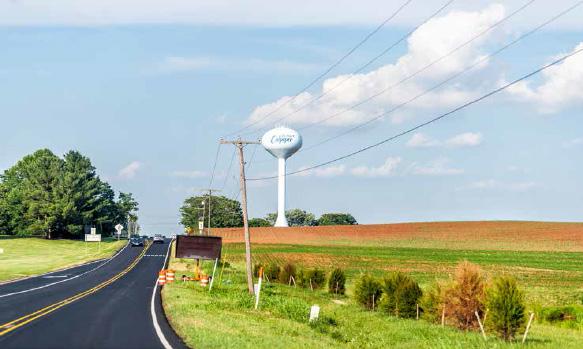















29 Cellular AMI Industry Leading Metron Farnier is dedicated to providing rural utilities with a reliable, robust and cost e ective Cellular AMI system. Reliable signal transmission with network partner Zero infrastructure costs! Consistent daily reads with our user friendly web platform No monthly or annual fees! Contact Tim Jackson to schedule a meeting or request a quote 720-425-2846 - tjackson@metronfarnier.com www.MetronFarnier.com Celebrating 22 years in business! CONTACT US 24/7 @ (816) 833 -8109 Shop • Mark Peden (816) 820-6955 | Kelly Peden (816) 830-6841 • Service Paul Dover (816) 616-8031 • Sales Dan Ellis (816) 266-6557 • Sales Charlie Johnson (816) 489-0935 www.alliancepump.com We are a Full Service and Installation Company • Complete repair of all makes and models of pumps, motors, gear boxes, blowers, valves and controls • Complete Package Lift Stations and Rehab Lift Stations • Deep Well Service, Clarifier Repair, Pump Testing • 24-hour Emergency Service • In-House Machine Shop • Balancing Shop and Field • Electrical Panels and VFD’s • Mechanical Seals and Packing • Preventative maintenance programs 627 S. Cottage St Independence, MO 64050


30 SMICO CONTRACTING • Water/Wastewater Treatment Plant Rehab • Valve Replacement/Repair • Flowmeter Replacement • Pump Replacement/Repair • Manhole Rehabilitation • Jetter/Vacuum Services • Lift Station Rehab/New Installation • Piping and Manhole Inspections Contact Us Today! Office: (816) 229-2244 Darryl Smith: (816) 582-9521 Tim Trigg: (816) 699-9141 Mason Smith (816) 651-3527 Email: SmicoConstruction@Smico1.com Website: smicocontracting.com

31
MRWA’s Newest Acronym - WQAS
Loyd Rawlings, Water Quality Action Specialist


In the world of acronyms Missouri Rural Water Association added a new one in April 2022: EPA WQAS or Water Quality Action Specialist. This WQAS position is funded by an EPA grant and was added to assist wastewater facilities serving a population of 10,000 or less. The WQAS is a technical assistance/ training position requiring 325 hours of training whether it be formal classroom training or physical onsite one-onone training. The WQAS targets overburdened and manufactured housing wastewater systems and small systems dealing with regulatory violations and/or compliance issues. As of October 2022, over 23 small systems facing violations or compliance issues had been visited. Additionally logged have been more than 130 hours of on-site assistance for 45 systems, and more than 40 hours of formal classroom trainings with 38 separate systems in attendance.
In this trying economy, asset management is probably one of the best tools available to every utility out there. So, the focus for formal training is asset management and utility sustainability to address this issue. The goal is to bring asset management to the forefront to help systems: understand what assets they have, understand the worth of those assets, understand the level of service the system can provide, an understanding of system assets with emphasis on critical assets, and funding options available whether it be NRWA, Mo SRF, USDA or other available grants and loans. By building a firm foundation on asset management, decision-makers and employees
can make more informed decisions. This will also lend itself to looking into future projects, not only with asset management in mind, but also sustainability. This oneday class only scratches the surface of asset management but gives the attendee a basic understanding of asset management as it pertains to a sustainable system.
Inflow and Infiltration are monsters that seems to creep up on all systems. Another class being offered is an Inflow and Infiltration class with a hands-on smoke testing portion. This class has been well received by 15 different systems, and a couple of government agencies, as well. The hands-on portion of the class lets the student get real-time, real-world experience in locating places where inflow and infiltration can occur in the sewer system. Inflow and Infiltration can mean higher treatment costs, environmental issues, and possible fines from sewer overflows.
The newest class offering on the MRWA training calendar is Chemical Feed Pumps and Discharge Permits. Chemical feed pumps can be a costly investment, an investment which if not properly maintained, can grow rapidly. This class explores calibration and verification of the pump and dosage which helps to gather data about the pump characteristics so that proactive scheduled maintenance can occur as opposed to reactive emergency response to breakdowns. This class will also cover the basic math used in the calibration and verification process, as well as dosage math for a better understanding of how many gallons of a liquid product will be pumped in a day. The second part of the class will discuss discharge permits and will cover not only site specific NPDES permits, but also MOG general discharge permits.

32
Discussions will include how to read the permit limits, schedule of compliance (if applicable), future limits, and monitoring-only testing. With this new position, MRWA can offer more classes across the state of Missouri, with an emphasis on targeting those systems serving populations under 10,000 population, overburdened, manufactured housing, and small wastewater systems. Check the MRWA Training page, www.moruralwater.org/training for the most current listing of class locations and available topics. If
are interested in hosting a class, please contact Loyd Rawlings, EPA Water Quality Action Specialist, at



















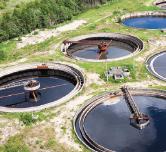


33
E le c t romagnetic Fl ow M e t er s Wa t er dist r ibution, p lant w a t e r and w as t e wa t er appl i c a t ion s Ult rasonic Fl ow M e t er s Wide r ange of liquid me t e r ing applic a tion s Vo r t ex Fl ow M e t er s A ir and liqui d inse r tion s t y l e D i e re n tial Pressu re Fl ow M e t er s Wide r ange of liquid and ga s me t e r ing applic a tion s Mass Fl ow M e t er s Highly accurate chemical injection metering (913) 381-5581 • Messplay.com 7822 Conser Place • Overland Park, Kansas 66204 Messplay Machinery is here to help you with all of your water and wastewater ow metering applications. Contact Messplay for help with the complete line of Badger Meter ow metering solutions. Applications include: • Well water • Treatment plants • Pump stations • Distribution • Lift stations • Influent • Effluent • Reclaimed water • Discharge • Chemical injection "Providing solutions for informative decisions on storage tanks." www.tankspek.com 800.624.1023 info@tank s pek.com JOPLIN, MO BAXTER SPRINGS, KS BERRYVILLE, AR I n spection + Ser vi ce + Coating + Repair
you













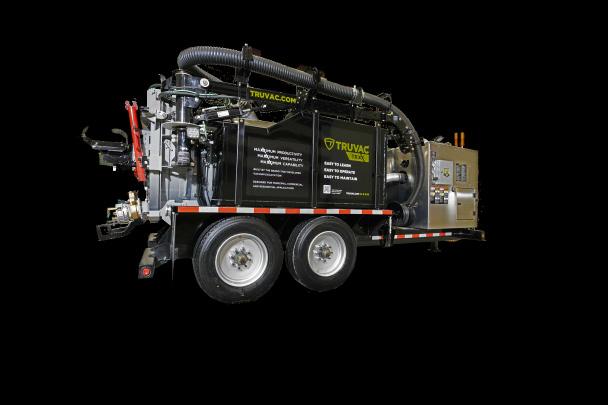
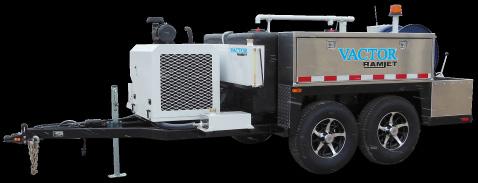
34 www.coe-equipment.com parts@coe-equipment.com sales@coe-equipment.com We proudly distribute these quality manufacturers: ANY and ALL parts and accessories for your industrial or municipal sewer equipment, including... • Debris & Jetting Hoses •Pipe & Pipe Clamps •Hose Guides •Hose Fittings & Menders •Nozzles •Filters & Gaskets •Reel Repair Parts •Gauges •Tools Plus, the best digging accessories available! WE’RE HERE FOR YOUR TRAILER NEEDS! www.coe-equipment.com TRUVAC TRXX Trailer Vac Ramjet Trailer Jetter
Rural


35
Water Fleet
The National Rural Water Association has created partnerships with motor groups to offer discounts to utilities around the country. Member utilities should contact their State Rural Water Association to access the Rural Water Fleet Program. Visit https://nrwa.org/members/products-services-portfolio/ fleet-program/ for up-to-date information.
Program
Water Meters: Cash Registers for the System
Brad Rayburn, MRWA Circuit Rider

The amount of funding that is available to water/ wastewater systems to improve infrastructure is astronomical. This funding is available through the Missouri Department of Natural Resources (MoDNR) and the US Department of Agriculture (USDA). This funding can be used for most anything related to water/ wastewater infrastructure. Many water systems that apply for funding use these funds to replace their existing meters. New meters help lower water loss and increase revenue. Water meters are the cash registers for water systems.
Sometimes this is forgotten by water district boards and city councils because they are uneducated on this fact and feel sympathetic to those that elected them. For a meter to work, water must go through the meter. If water does not go through the meter, then the register on the front of the meter does not calculate, resulting in an unchanged reading. Often, customers win the argument when they question the accuracy of the water meter. This is a situation that happens all too frequently. The customer attends a board/council meeting and says, “There is absolutely no way that I could have used 30,000 gallons of water in a month without a lake being in my yard.” The water specialist checks the meter and confirms that no water is going through that meter at the time it is verified. The 30,000 gallons of water is just an example, this situation happens when less or more water is used. The council or board sides with the customer, refunds their money, reduces the bill, and instructs the water specialist to change that bad meter. So, 30,000 gallons of water is forgiven because no explanation of where the water went, and the customer wins. This customer tells his neighbors and friends what took place, and now every month customers are attending the council/board meetings because their water meter is “bad”. It’s a snowball effect that is detrimental to the revenue for the system. Customers are taking from the cash register. After a few
months of these refunds, the system contacts MRWA requesting a rate study be performed. Afterward, every customer’s bill will increase to cover the cost of those refunds. It’s a vicious cycle.
So, let’s address the 30,000 gallons of disappearing water. 30,000 gallons of water through a residential meter setter calculates to 0.69 gallons/minute for a thirty-day period. How could that customer have used so much water without creating a lake in the yard? This situation gets more complicated because when the water specialist checked the meter, zero water flow was detected going through the meter. Where did this water go? There are multiple ways this water disappeared without creating a lake. The toilet may have stuck at some point during the month, the water heater pop off valve may have stuck open, the customer may have had a leak which was repaired, or the yard hydrant may have gotten left on overnight, etc. All these reasons do explain the outcome of the customer’s high-water bill.
Many systems are converting their old water meters to an Automated Meter Reading (AMR) system, or a cellular read water meter. The AMR consists of small low power radio transmitters connected to individual water meters. These types of systems do not rely on someone to manually read them. They read themselves and send that reading to a collector, typically a handheld or a laptop computer. The meter readings are then transferred to the billing software so that the water bills can be printed. This system eliminates many of the mistakes that are made when manually reading water meters. Also, water systems can print off the daily and hourly usage from each water meter though this option is not available on every one of these types of meters.
There are some variables to why meters don’t work properly and there might be some cases out there where a water meter did not properly read sometimes due to a manufacturer error. As meters have thousands of gallons
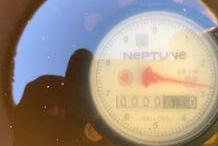
36
of water flow through them, they tend to slow down and not read all the water that flows through them. I strongly recommend having customer-questioned water meters tested for manufacturer error or not reading properly before a refund is given. For a water system, the meter is the cash register. Missouri Rural Water Association is available to assist with water meter issues or provide further information about water meters.
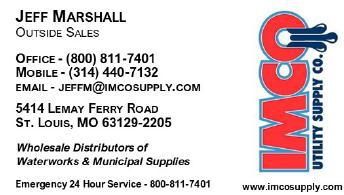

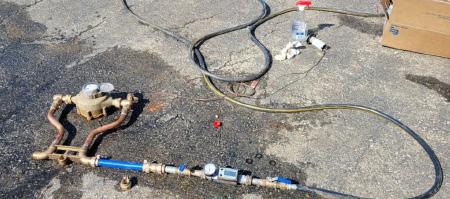
37
Love Your Lagoon!
Gary Webber, MRWA Wastewater Technician
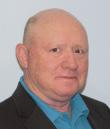

There’s an old lagoon at the end of 10th St., we don’t like it anymore. It’s all grown up with weeds, brush, and trees, muskrats have riddled the berms, it stinks sometimes, and never meets DNR’s limits. They say that’s Old School treatment and it’s not efficient or compliant. It will take too much time and money to fix it up.
Missouri just happens to have hundreds of lagoons serving their communities and some have been there for decades. Many may be approaching 70 or 80 years of service, some more, some less. They may not look like they once did and they may not function as good as they used to, (sounds familiar to me) but many lagoons that are being utilized for wastewater treatment still function well. In fact, lagoons can and do meet effluent limits even in today’s ultra-low NPDES limit-world.
Have these fabulous lagoons been upgraded over time? Many lagoons have been equipped with proven technological upgrades that have enhanced their performance. Are there more optional upgrades that can be added to help my lagoon work better and meet permit limitations? There are many upgrades, addons, and operational tools available that will put that lagoon on treatment steroids! Who knows how high the compliance limit bar will be raised in the future, but many of the lagoons I get to visit in my travels of Missouri are working great and are still compliant.
These old lagoons have a lot of “Badges of Honor”. They remove huge amounts of nutrients from the waste stream
and ultimately, the environment. They can handle hydraulic overloading much better than most mechanical plants. They have much better defense capabilities from toxic loadings vs mechanical waste-treatment facilities. Many lagoons have a very low operations and maintenance cost. In fact, many lagoons are connected to a gravity flow collection system. So, in the event of a power failure to the community or treatment facility, this lagoon just keeps on ticking and treats wastewater just like it always has with no negative environmental impact. Think about that!
Let’s consider your wastewater treatment facility’s vulnerabilities! The old lagoon is resilient, but there are some common ailments, with a few of those listed here:
• Lack of attention, starved for grooming and hygiene
• Too much food
• Lack of exercise
• Low oxygen at times or chronic oxygen deficiencies
When was the last time the Utility Board visited the lagoon? How much capitol is budgeted annually for taking care of this extremely critical asset? How much time is devoted to making that beautiful pond happy allowing it to work for you at its highest capabilities? When is the last time trees were cut around the lagoon? Can the lagoon see the sky?
If we take action and make changes to our management approach and operational habits, many of the
Phone: (217) 222-7154 Fax: (217) 222-7018 Toll Free: (800) 292-2535
http://www.richardselectricmotor.com/

38
2028 Quintron Way Quincy, IL 62305
Electric
Motors Rewound, Rebuilt, and Repaired New Motors * Controller Service * Metalizing
vulnerabilities can become a “whisper of the past.” And it could be that because folks don’t understand lagoon processes, the lagoon then suffers from neglect. It took a lot of money to build that beauty. In today’s world, your lagoon is worth a lot more than you can imagine.
Some more common issues that lagoons suffer are:

• Too much sludge accumulation
• Lack of wind shear, low oxygen at times, lack of mixing
• Short Circuiting
• Too much inflow & infiltration (I&I)
• Too shallow, undersized
• No fluctuation of water levels
• Duckweed, muskrats, weeds, brush, livestock (invasive environment)


• No money to operate on
These are all manageable issues and if this sounds familiar, we need to fix these first, and then make plans to upgrade with some highperformance industryproven technologies. I have yet to see a “Silver Bullet” that fixes all nutrient removal deficiencies at lagoons. There are technologies available for enhanced ammonia removal that should help with more consistent compliance of discharging water quality. However, many of these technologies come with a heavy Operations and Maintenance Cost. Utility decision-makers should review any new treatment technology or upgrade cost including O & M costs very diligently. The amount of capital needed for electrical power, increased workforce, increased monitoring, increased replacement of critical components, etc., can be hundreds of thousands of dollars
annually. This would be unsustainable both operationally and financially for many communities. Please look at these issues before buying in to what is offered your way. Most new treatment schemes should incorporate a combination of proven remedies to raise the performance of treatment prior to discharging. Sludge removal, bar-screens, curtains, aerators, micro-graduated drawoff structures, covers, return pumps, biologic therapy, oxidizer therapy, disinfection chambers, land application, etc. These technologies come in a variety of styles and applications to best fit your specific needs. If you have an engineering firm that you work with, have them look at some of the available upgrade options to see what will best fit your lagoon.
As always, you can call MRWA for questions and assistance. Our wastewater technicians can stop in on-site to discuss possible options.
I love lagoons. If you have a lagoon, treat it well and it will love you back!
39






SUPERIOR CUSTOMER SERVICE





41
Faces of

Curtis Bennett is the Ashland Water Utility Superintendent. His career in the water industry spans 32 years. Mr. Bennett maintains DS-II and WW-D certifications. He notes growth as the biggest challenge facing the city’s utilities. Ashland is among the fastest growing communities in the state with additional companies moving to the community - fueling additional growth. Ashland’s water utilities are in good hands under Curtis Bennett’s guidance. Curtis enjoys fishing, woodworking, and landscaping in his spare time.
Lawrence Henson works for Alliance Water at Bowling Green. He began in the street department progressing to his current position, Chief Water Plant Operator. Mr. Henson has nearly 30 years of experience, with an extensive background in maintenance, construction, and the water industry. Lawrence holds DW-A, DS-III, and WW-B certifications. His hobbies include vacationing at Gulf Shores AL, attending the Midwest Old Threshers Reunion in Mt. Pleasant IA, and gardening. Lawrence believes regulations are the biggest challenge facing the water industry.
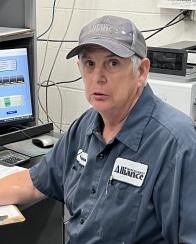

Tina Redding has many responsibilities at the city of Calhoun. She serves as the office professional and as the Chief Water System Operator. She has served in the water industry since 2001, holding a DS-II certification. Tina previously worked in the healthcare and education fields. She lists small communities’ financial abilities to address rules and regulations as an industry challenge. Tina exemplifies people dedicating themselves to their hometown. Tina enjoys hunting, fishing, and spending time with family and friends. Her friend group is named the “Calhoun Mud Dobbers”. Tina was recently honored as MRWA’s 2022 Office Professional of the Year.

Rural Water
Jim Tickle has 25 years of experience in the water industry. Mr. Tickle began his career an entry-level employee progressing to the Grundy County PWSD #1 Superintendent. He maintains a DS-III certification. Jim notes his favorite part of the job is being outdoors. He considers meeting regulations on a limited budget as the biggest work challenge. Jim enjoys outdoor activities including gardening, hunting, fishing, and camping. My personal thank you to Jim for his suggestion concerning MRWA training class scheduling. Great advice!
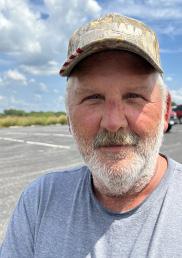
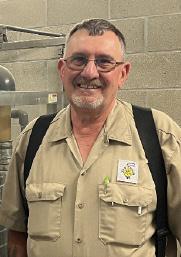
Sharon Cornelius serves as the manager of Andrew County PWSD #2. Sharon has an accounting background with previous experience in the healthcare industry and at a non-profit organization. During her brief tenure the district has implemented several major waterline projects and a meter replacement plan. Sharon sees developing future professionals, aging infrastructure, and future regulations as industry challenges. She emphasizes our industry has a bright future as we are a tenacious group that will dig deep to meet those challenges. Sharon enjoys reading, walking, hiking, and mentoring young people.
Steve Reid is the Chief Water Plant Operator at Trenton. Steve has an extensive background in the water industry spanning 43 years. Steve is a retired Navy veteran, with 21 years of military service. Mr. Reid retains DW-A and DS-III certifications. He noted that replacing the aging workforce and loss of institutional knowledge as a current and future challenge for the water industry. Steve’s hobbies include fishing and shooting sports.
If you’d like to share a colleague, co-worker, or your own face and story with the readers of MRWA’s Missouri WaterLines, contact Jim Patton by phone at 573-337-0053 or by email at jpatton@moruralwater.org.



A Seamless Upgrade
Extreme weather conditions coupled with outdated equipment can mean constant repairs, loss of data, and overtime for busy workers in the water and wastewater industry. Learn how SEL partnered with a local municipality in Georgia to upgrade their system, giving them a level of reliability they can now extend to their community and its water and wastewater system.
Learn more at selinc.com/waterlines.
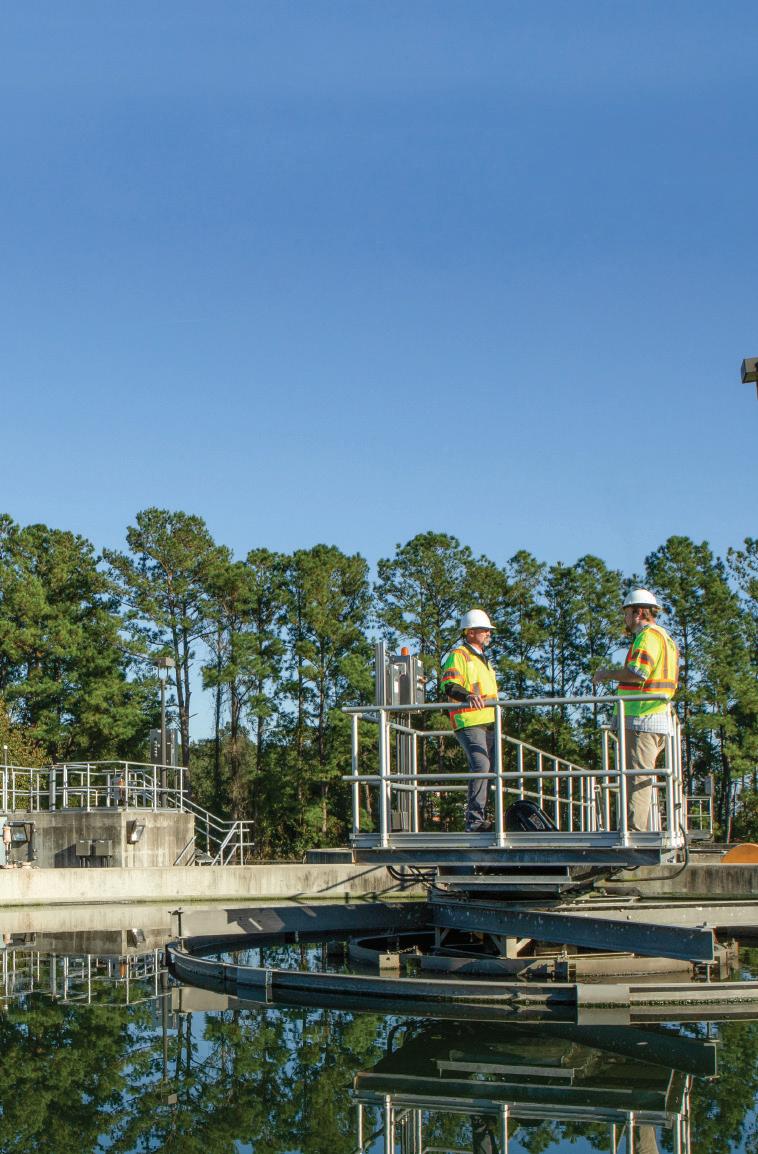
44
The Many Hats of a Small Town City Clerk

 Ami Dieckman, MRWA Circuit Rider
Ami Dieckman, MRWA Circuit Rider

All day, Every day! One interruption after another! Eventually they’ll get their work done, and hopefully with no errors! This is the life of the small-town city clerk. They’re working on an ordinance for the council meeting next week, while filling council packets, and trying to complete payroll, while a citizen is standing at the window to pay their water bill, and another citizen is on the phone complaining about the neighbor’s dog! They juggle interruption after interruption and endless small tasks daily. Of course, they get a slow day here and there amongst the chaos.
City clerks often do their jobs alone. Some cities have a collector or deputy clerk, but often this position is part-time. This makes it difficult for city clerks to work uninterrupted. These clerks must wear many hats each day. They are the utility clerk, the city clerk, the human resources manager, the payroll clerk, the treasurer, and this list keeps going. Occasionally a clerk may finish a task and not feel stressed or pressured, but the simplest task may be disrupted multiple times before completion. Not only does this sometimes feel as though the task took too long, but sometimes stepping away from a duty to work on another task may create room for error. This can be frustrating when the clerk realizes something was missed or overlooked. This can also create a stressor for clerks constantly having a fear of forgetting to do something important.
Clerks have many important duties and numerous important deadlines. Time management and organizational skills are key elements in the life of a city clerk. Keeping a calendar and keeping it well detailed
can be one of the best bits of advice to ensure keeping on task. Sometimes the clerk just needs to know when it’s a good day to shut the door and focus on getting the project done. Often in small towns the clerk has a big hand in helping the operator get reports done as well. The clerk must learn to prioritize their day and be able to push things aside for a later time. Checklists help of course but they’re not fool proof!
This may very well be a root of high turnover in city clerk positions. It can be highly stressful for a clerk to make it through the first 3 years of being a city clerk. They spend the first year trying to figure out what they should do. The second year they’re still trying to figure these things out while hoping they didn’t royally mess things up during their first year. The third year comes around and they’re starting to figure out their ways and feel more confident in their duties. The support group around a new clerk needs to be strong.
It’s good to think about this dynamic if you work with a city clerk. Operators and boards should give patience and grace for a couple different reasons. Sure, any job can have varying amounts of stress. When your clerk has 6 tabs open in their brain, and the operator walks in and asks for another task to be you thought you should get. If an important deadline is missed and the clerk doesn’t typically make these errors, you should give grace and know the clerk already hopes it never happens again. Just remember your clerk didn’t just sit down and write your paycheck, they probably worked on 7-8 other things in the middle of it.
45
Pictured: Kerri Peters, Operator/Clerk for the City of New Hampton
Apprenticeship Update
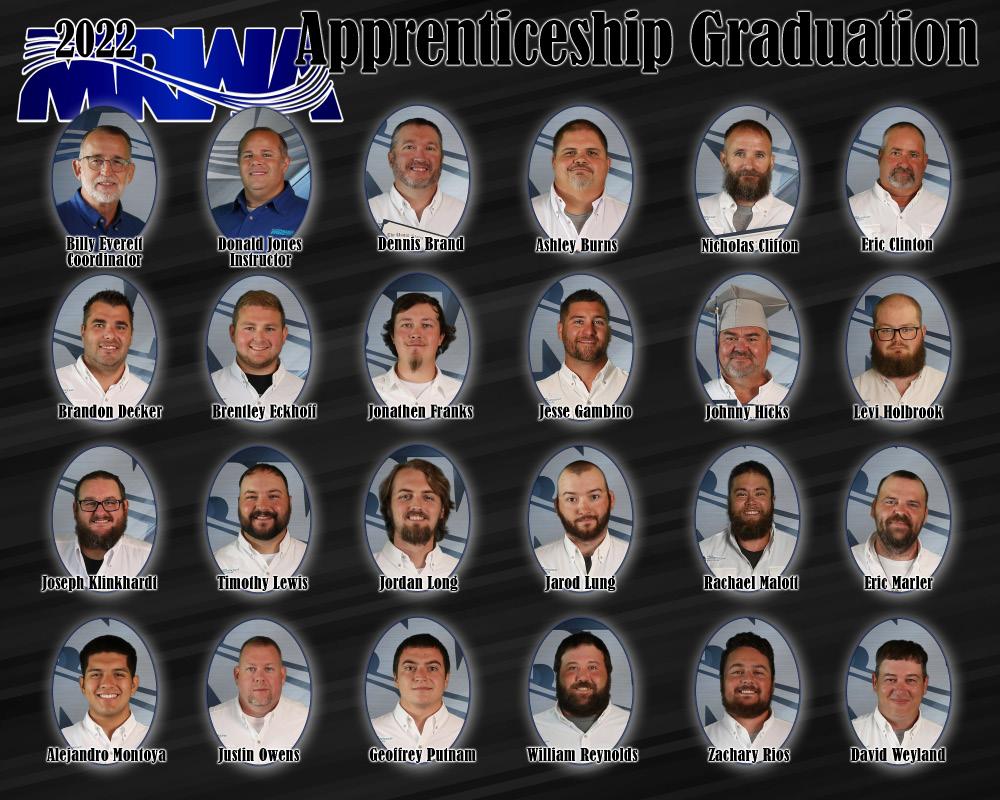 Billy Everett, MRWA Apprenticeship Coordinator
Billy Everett, MRWA Apprenticeship Coordinator
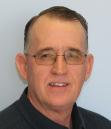
The MRWA Apprenticeship Program held its promotion ceremony for the latest group of advancing apprentices in water and wastewater systems operations on Friday, August 12 at the Mighty Oak Lodge in Lebanon. The crowd, numbering nearly 100, included the apprentices, family and friends, system managers and mentors, MRWA staff, and US Department of Labor (US DOL) Apprenticeship and Training Representative Tracy Laughery. The 2-year program has now promoted a total of 27 apprentices to journeymen. Prior to the promotion ceremony, Missouri’s MRWA ranked #1 in the nation for its number of apprentices enrolled in the program with 71 apprentices. There are currently 34 states with water/wastewater operations apprenticeship programs with the total number of apprentices reaching 396 in the nation. The MRWA Apprenticeship Program is proud to recognize these new Water & Wastewater Journeymen into our industry.
At the heart of any Apprenticeship Program is an investment in our #1 resource…the individual. The development of a well-trained and well-rounded employee is a win-win situation for the employee, the employer, MRWA and our industry. It takes a total team effort from all partners. A registered Apprenticeship Program is a promise to Apprentices that we agree to
46
train them at a level that will further their career in this industry and a promise to employers to provide a focused education that will result in an upward development to their workforce. An example of this teamwork can be seen in the requirements needed for the current four (4) on-going Apprenticeship Programs that include an additional 44 Apprentices and 42 mentors. To accomplish this will require that multiple instructors will need to provide a minimum of 12,672 hours of related technical instruction (RTI) to these Apprentices and will also require the Apprentices to log a minimum of 176,000 on-the-job (OJT) training hours. This is what investments in our industry’s future workforce looks like. It’s easy to see that there are a lot of moving parts to this process, but MRWA has a Board of Directors, Executive Director and Staff that are committed to providing these new opportunities for the Water & Wastewater industry. We’re currently looking to expand these efforts and upcoming Programs are in the planning stages.
If you or your system are interested in upcoming Apprenticeship opportunities, contact Billy Everett at beverett@ moruralwater.org
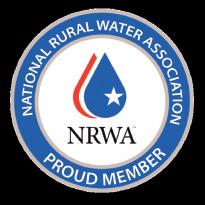









47 Free Online Training Representation at the National Level Access to Member Portal Discounts on NRWA Event Registrations Access to NRWA Online Community Discounts at the NRWA Store Membership e-newsletter updates Subscription to Rural Water Magazine Become a NRWA Supporting member today! NRWA Supporting Members Recei ve: For more information, contact Chance Winslett at chance@nrwa.org or 580-252-0629 or by visit www.nrwa.org/members


48 When it absolutely, positively must last. www.midwestinfrastructurecoatings.com The OBIC lining system is the highest quality protective coating and lining system designed for long life corrosion and infiltration resistance on the market today. America’s underground infrastructure is aging and failing. Ground water infiltration and corrosion are just a few of the major problems that municipalities and sewer districts are faced with daily with underground infrastructure failure. Midwest Infrastructure Coatings LLC has the trenchless solution to these failing issues by rehabilitating the underground infrastructures rather than costly replacement. Midwest Infrastructure Coatings LLC is a Missouri-based family-owned small business, servicing a four-state region in the Midwest (Missouri, Arkansas, Oklahoma, Kansas). Contact your Missouri Sales/Service Associate: Michael Vavruska 417.630.8852 mvavruska@midwestinfrastructurecoatings.com Manholes Wet Wells Pump Stations Lift Stations Clarifiers Aeration Basins Chlorine Contact Chambers Potable Water Secondary Containment Large Diameter Pipe ...and more We Service: Certified Installer of the OBIC Lining System
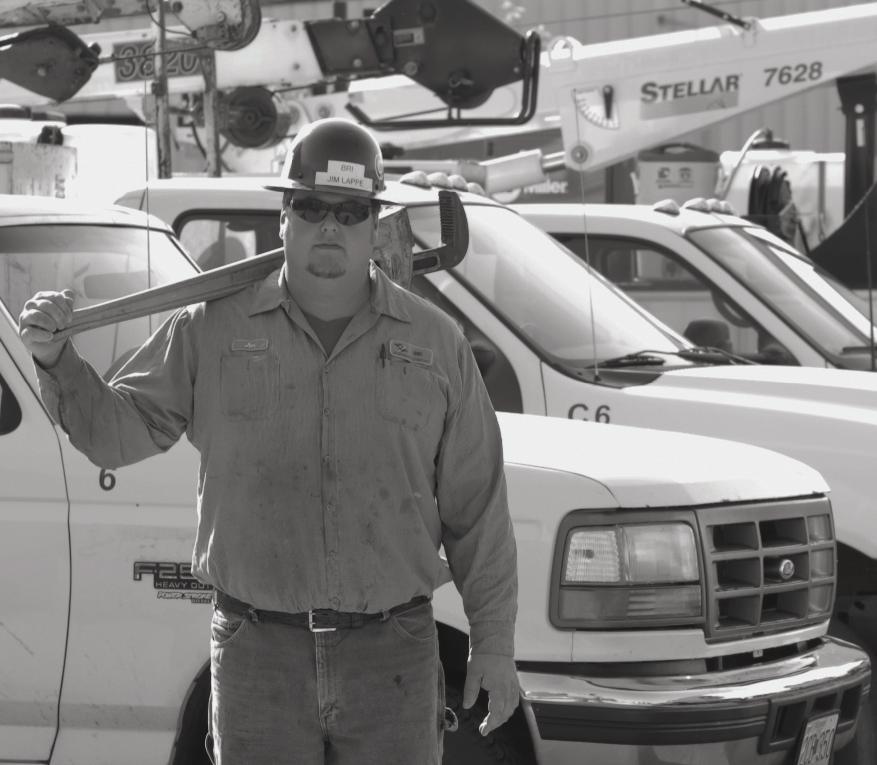

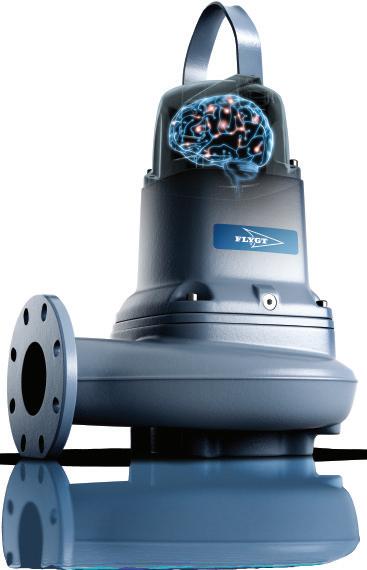
WE ANSWER 24/7 Choose the Right Partner 636.343.8880 vandevanter.com NATIONAL STRENGTH - LOCAL SERVICE - EMPLOYEE OWNED WHEN YOU CALL ...
Little Otter Creek Reservoir: A 30 Year Rural Water Journey and Success Story
 Julie Marks, PE, Allstate Consultants
Julie Marks, PE, Allstate Consultants


le O#er Creek Reservoir: A 30 Year Rural Water Journey and Success Story Marks, PE, Allstate Consultants
After 30 years of hard work and determination, the end is in sight for Caldwell County residents plagued by water supply uncertainty and scarcity. Construction began this spring on the Little Otter Creek Reservoir (LOCR) located 3 miles east of Hamilton, just south of Highway 36. The $26 million dollar reservoir will provide 1.24 million gallons of water per day for Caldwell County, meeting the 50-year projected demand which will help sustain population and promote economic growth in the vicinity. In addition to water supply needs, it will serve as a recreational venue for approximately 60,000 annual user-days as well as help reduce the agricultural and infrastructure damage from flooding downstream of Little Otter Creek. The reservoir is expected to positively impact local businesses and the over 9,000 residents of Caldwell County.
Caldwell County water usage was so severely restricted that water could not be used to water livestock. Area farmers were considering slaughtering their cattle when the desperately needed rains arrived. Digital models estimate that if another record drought were to occur, the existing water sources could only supply approximately 37% of the water needed. This restricts the ability of local farms and businesses to expand and encourages new businesses to build their facilities elsewhere.
er 30 years of hard work and determinaGon, the end is in sight for Caldwell County residents plagued water supply uncertainty and scarcity. ConstrucGon began spring on the Li#le O#er Creek Reservoir (LOCR) located 3 miles east of Hamilton, just south of Highway 36. The $26 million dollar reservoir will provide 1.24 million gallons of water day for Caldwell County, meeGng the 50-year projected demand which will help sustain populaGon and promote economic growth in the vicinity. In addiGon to water supply needs, it will serve as a recreaGonal venue for approximately 60,000 annual user-days as well as help reduce the agricultural infrastructure damage from flooding downstream of Li#le er Creek. The reservoir is expected to posiGvely impact local businesses and the over 9,000 residents of Caldwell County.
dam will be 81 feet tall and 2,400 feet long. Water at the will be about 60 feet deep and the reservoir will have 9.3 miles of shoreline. The 344-acre reservoir will be slightly larger the 205-acre Li#le Dixie Lake in Columbia, MO, but much smaller than the 1,600-acre Clearwater near Piedmont, MO.

Li>le O>er Creek Reservoir drawing. Picture courtesy of Allstate Consultants
need for a new water supply source in Caldwell County is undeniable. Studies show that nearly 100% Caldwell County is suscepGble to severe drought and unreliable water sources. During a recent drought, Caldwell County water usage was so severely restricted that water could not be used to water livestock. Area farmers were considering slaughtering their ca#le when the desperately needed rains arrived. Digital models esGmate that if another record drought were to occur, the exisGng water sources could only supply approximately 37% of the water needed. This restricts the ability of local farms and businesses to expand and encourages new businesses to build their faciliGes elsewhere.
Pictured: Hamilton Reservoir with approx. 1 month of water supply remaining
The dam will be 81 feet tall and 2,400 feet long. Water at the dam will be about 60 feet deep and the reservoir will have 9.3 miles of shoreline. The 344-acre reservoir will be slightly larger than the 205-acre Little Dixie Lake in Columbia, MO, but much smaller than the 1,600-acre Clearwater Lake near Piedmont, MO.
The water issues in northern Missouri are a result of unfortunate geology. Many communities in other areas of Missouri obtain their water from large rivers and may supplement their water supplies with groundwater. Other communities primarily use groundwater and may use surface water to supplement their water supplies. Unfortunately, in Caldwell County, large surface water sources are not available. In addition, the use of groundwater as a primary or secondary source of drinking water is not feasible because the underlying geologic formations severely limit and impair groundwater quality and availability. Shallow wells that are drilled yield little water, and deeper wells either yield little water, or yield water high in sulfate, chloride, and total dissolved solids. Treating water of such poor quality is costly for water treatment plants and places an additional economic burden on a community with a poverty rate above the state average.
The water issues in northern Missouri are a result of unfortunate geology. Many communiGes in other areas of Missouri obtain their water from large rivers and may supplement their water supplies with groundwater. Other communiGes primarily use groundwater and may use surface water to supplement their water supplies. Unfortunately, in Caldwell County, large surface water sources are not available. In addiGon, the use of groundwater as a primary or secondary source of drinking water is not feasible because the underlying geologic formaGons severely limit and impair groundwater quality and availability. Shallow wells that are drilled yield li#le water, and deeper wells either yield li#le water, or yield water high in sulfate, chloride, and total dissolved solids. TreaGng water of such poor quality is costly water treatment plants and places an addiGonal economic burden on a community with a poverty rate above the state average.
The need for a new water supply source in Caldwell County is undeniable. Studies show that nearly 100% of Caldwell County is susceptible to severe drought and unreliable water sources. During a recent drought,
Many challenges had to be overcome before construcGon could begin. The suitability of exisGng sources surface water and groundwater were evaluated and the feasibility of developing new surface water or groundwater sources was invesGgated. Then the best locaGon for a mulGpurpose reservoir had to be
Many challenges had to be overcome before construction could begin. The suitability of existing sources of surface water and groundwater were evaluated and the feasibility of developing new surface water or groundwater sources was investigated. Then the best location for a multipurpose reservoir had to be studied. Meanwhile, the Caldwell County Lake Project Steering Committee was working to
50
Little Otter Creek Reservoir drawing. Picture courtesy of Allstate Consultants
Pictured: Hamilton Reservoir with approx. 1 month of water supply remaining
grow community and legislative support for the project. These efforts culminated in the Natural Resources Conservation Services (NRCS) designing a multipurpose reservoir in the Little Otter Creek watershed that would provide much-needed drinking water, reduce flood impacts along Little Otter Creek, and provide recreational activities for the area.
Funding the $26M LOCR project was also no easy task. The planning, engineering, and construction of the LOCR project required funding from several sources. Federal funds were secured from the USDA-Natural Resources Conservation Service through the Watershed Protection and Flood Prevention Program (PL 83-566), which paid 100% of the planning and engineering cost, and 58.1% of the construction costs. Additional support came from the State of Missouri in the form of direct appropriations and through the Missouri Department of Natural Resources’ Multipurpose Water Resources Fund. Finally, local funds were generated from county-issued bonds and a local Caldwell County ½ % sales tax. Together, these resources were combined to bring the project to reality.
Of course, there were environmental concerns that had to be addressed. Potential environmental impacts were extensively reviewed in an Environmental Impact Statement originally published in 2003 and then supplemented in 2019. The Final Supplemental Environmental Impact Statement and the resulting Record of Decision were the final steps in the completion of the National Environmental Policy Act (NEPA) requirements for the project. While it was determined that no federally threatened or endangered species, and no state endangered species, were present, studies did reveal that installation of the Little Otter Creek Reservoir would result in unavoidable temporary and permanent
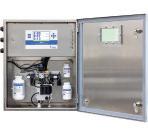

impacts to jurisdictional waters of the U.S. An individual 404 permit was approved in October 2020 and included the requirement for compensatory mitigation for adverse impacts to approximately 36,243 linear feet of stream and 4.1 acres of jurisdictional wetlands.

Mitigation for the Little Otter Creek Reservoir project includes implementing measures designed to reduce undesirable environmental effects as well as funding activities that will offset unavoidable ecological impacts. The Little Otter Creek Reservoir project contributed funds to help complete projects that restore wetlands, riparian forests, streams, and prairies in Missouri and provide conservation education opportunities. In addition to funding these projects, the Little Otter Creek project will complete four Aquatic Organism Passageway (AOP) projects. These AOP’s will remove barriers to the movement of aquatic organisms through and between bodies of water by replacing four low-water culvert crossings with bridges designed to allow aquatic organisms to move through these areas more readily. The culverts were generally perched above the stream bed
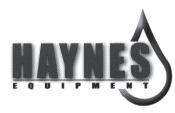
51 Manufacturer’s Representative for Water & Wastewater Treatment Equipment “If we supply it, we make it work!” Chloramination Monitoring You Can Rely On MCX™ Monochloramine Analyzer 888-534-4708 | watts.com/mcx
Old Hauns Mill Bridge
(continued on page 56)

52




53

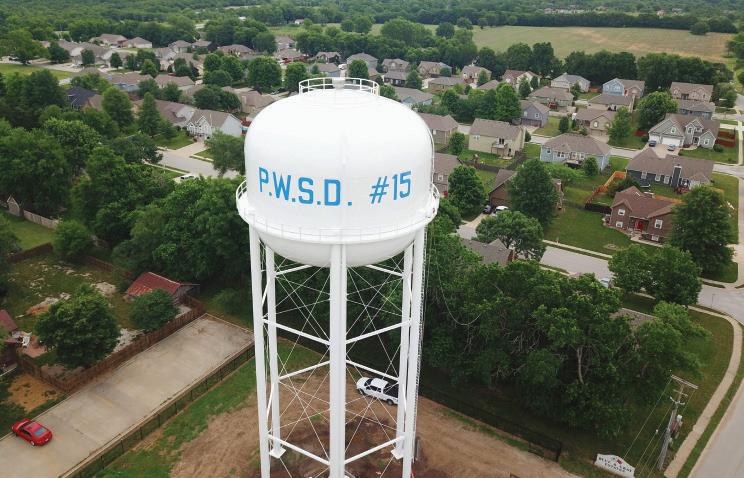


55 Providing engineering and land survey services to Missouri water and wastewater systems for over 60 years. 9001 State Line Rd., Ste. 200 Kansas City, MO 64114 816.361.0440 LampRynearson.com Contact us!
at the downstream end. The bridges will have rip-rap grade controls to maintain current stream bed elevations upstream of the crossings. The existing crossings were generally in poor condition and needed replacement from a traffic continuity and safety perspective. Additional benefits will be that the new bridges are designed to span the streams, reduce the risk of bridge overtopping or failure during flooding events, and reduce maintenance costs. The improved fish passage may also increase populations of other wildlife that depend on fish for food. To date, one AOP has been completed, one is nearing completion, and the other two will be completed by spring 2023. The reservoir team appreciates regulators working with them to find value-added mitigation opportunities that meet the permit requirements and replace outdated infrastructure.
The Little Otter Creek Reservoir is a multipurpose reservoir and has the potential for many recreational amenities. Recreational planning assistance has been provided through the Rivers, Trails, and Conservation Assistance (RTCA) Program with the National Park Service. With the assistance of RTCA, many stakeholder engagement meetings have been held to capture the community’s vision for recreational needs and a conceptual recreational master plan has been developed. There are possibilities for fishing jetties, trails, boat ramps, restrooms, parking, disc golf course, camping, docks, a butterfly park, as well as others. It will be many years before many of these recreational plans can be funded and completed, and some of the plans may never reach fruition.
The next task in the planning stage is developing a source water protection plan. Water sits at the lowest point in the

landscape and is susceptible to contamination from a variety of sources throughout the watershed. The Commissioners will be working with engineers and community members to identify potential sources of contaminants and working to find long-term solutions that ensure the highest quality water at the best price.


Reservoir construction is set to be complete in the spring of 2024 and the reservoir is projected to be filled with water and ready for use in 2029. During that time, the Little Otter Creek Wholesale Water Commission will continue to work towards funding and constructing the necessary water treatment facilities, water transmission mains, and water distribution system.
After many years of meetings, permitting, and discussions, the Little Otter Creek Reservoir is becoming a reality. This project is an excellent example of collaboration between many different people and government organizations, including citizens of Caldwell County, Caldwell County Commission, NRCS, U.S. Army Corps of Engineers, Missouri Department of Natural Resources, State Legislators, Federal Legislators, Allstate Consultants, Olsson Engineering, Green Hills Regional Planning Commission, National Park Service RTCA, and many others.
56
(continued from page 51)
Replacement Hauns Mill AOP Bridge

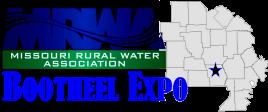
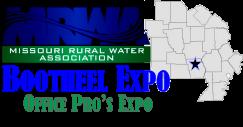




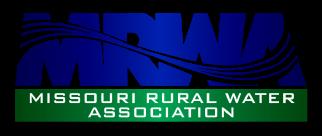






CONFERENCES 301 S 5TH ST POPLAR BLUFF, MO AUGUST 22 - 23, 2023 AUGUST 22, 2023 LAKE OF THE OZARKS OCTOBER 24 - 25, 2023 OCTOBER 26 - 27, 2023 www.moruralwater.org/conferences/ MARCH 7 – 9, 2023 ST. CHARLES, MO VISIT OR SCAN

58

















59






60

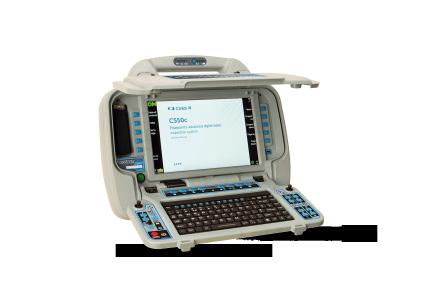
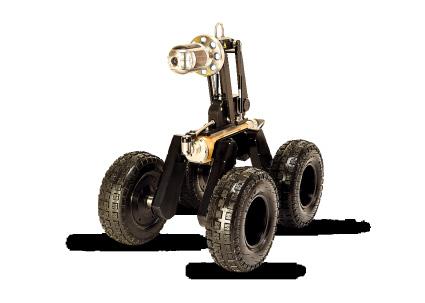
61 CUES C A portable, modular pipeline inspection – designed with you in mind. flexitrax C550c Controller Ready to use in 30 seconds from powering on, it requires minimal training to operate, letting you concentrate on the pipe inspection. flexitrax C550c Crawler The portable and modular crawler system enables operators to customize the flexitrax C550c solution for a vast range of pipes. https://cuesinc.com 800.327.7791 | salesinfo@cuesinc.com flexitrax C550c Brochure Don Hubbard, RSM 407.750.1001 | dhubbard@cuesinc.com



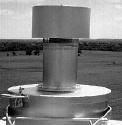
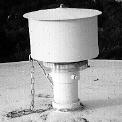

62 The safest way to maintain positive system pressure while your potable water storage tank is off line for repair or renovation. WE SPECIALIZE IN THE SANITARY ASPECTS OF WATER STORAGE: * Emergency or Sanitary Inspections & Evaluations * Critical Work-In-Progress Phase Inspections * Writing of Specifications * Short & Long Term Portable Tank Rentals * Consulting on Drinking Water Problems or Issues E-mails: tapco@fidnet.com or tomcatandtap@yahoo.com Website: www.tomcatconsultants.com Fax: 573-764-6255 Members: Clyde H. Zelch, Tina Keeney, Morgan Zelch, J.W. Zelch TOMCAT CONSULTANTS, LLC & dba T.A.P. Company Portable Hydro-Pneumatic Tanks Tank*Accessories* from 1,000 TO 25,000 Gallons !! Parts *Co. Ph: 573-764-5255 Ph: 573-764- 7255 Tank Sanitation Starts With A T.A.P. Co. Vent OUR PATENTED INSECT/FROST PROOF VENTS ARE DESIGNED TO PROVIDE SIMPLICITY, DURABIITY, SECURITY AND QUALITY. Other items we fabricate include: Roof Hatches, Ladder Sections, Davit Arms, Pressure Manways, Overflow Discharge Ends (flapgates), Roof Fan Flange Assemblies, Patented Triple Check Circulation Systems & Patent Pending powerMIX Tank Mixing Systems







63 • Text & Email Alerts • Post Forms & Reports • Bill Payment Info • News & Events Every website includes: • Mobile-Friendly Design • Secure Hosting • Easy Updates • Unlimited Support Get a Website in Just 3 Days! Call Today (888) 551-4815 Free Trial • Friendly Support • Money-Back Guarantee At RuralWaterImpact.com and MunicipalImpact.com we host beautiful, easy-to-use websites for hundreds of small towns and water systems across America. Simply sign up and we launch your new site in just 3 days or less! Then make edits or post alerts yourself anytime you like! Need help? No problem – Support is unlimited! Does your town or water system need a great website? “We love our new website! This is the best decision we ever made!” Official Partner Trusted website provider for more than 1,400 small towns and water systems across America!
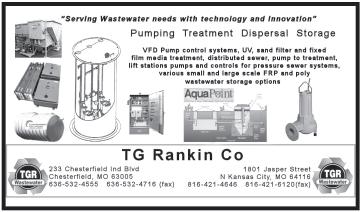
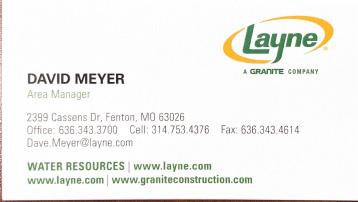


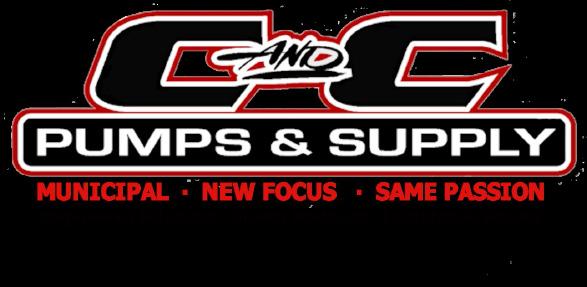
64 EngineeredSolutions Stocked Warehouses CLA-VALExperts Oncall24/7 Certified Electrician Sales Rentals Service Installation Custom Fabrication Marion, IL ~ 618-997-2311 St. Louis, MO ~ 314-780-0185 candcpumps.com steam@candcpumps.com













65 Contact Bart Downing to learn more! 816-387-3559 • bdowning@alliancewater.com
COMPLIANCE Gain more control as we focus on building positive relationships with regulatory officials, staying well-educated on policy and providing diligent monitoring and reporting. AllianceWater.com Choose a partner who can bring balance to your water and wastewater operations.
REGULATORY

66


67
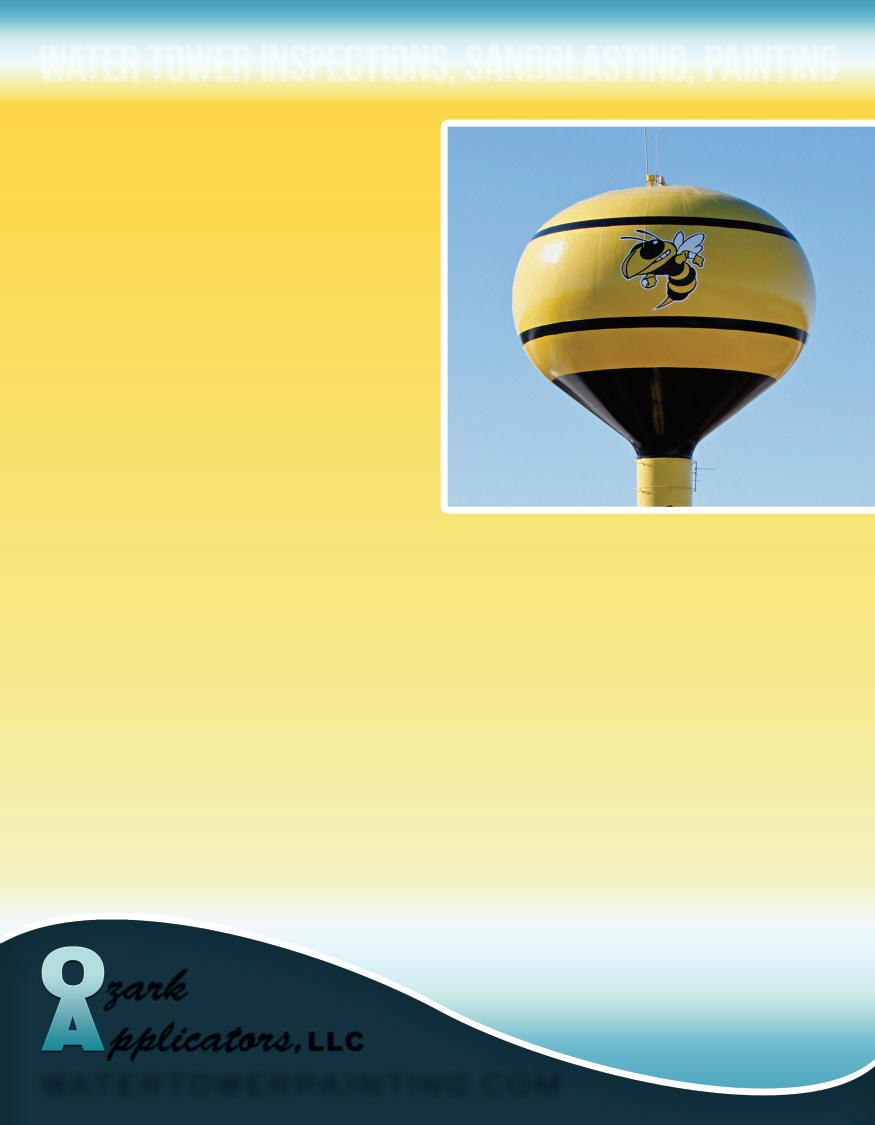

Providing water, wastewater, and underground utility solutions since 1963. Proud Distributor
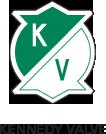

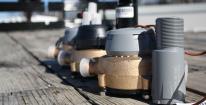





Cape

Branch
200 E. Franklin St. Edinburg, IL 62531
Ph: 800.634.4746

69
Corporate Office PO Box 318
Fx: 217.623.4216 Girardeau
1078 Wolverine Lane Cape Girardeau, MO 63701
Ph: 800.635.4746 Fx: 573.334.0151
MRWA Calendar of Events January

70
16
18–19
25
1
7 -
14
20
March 1
7–9
12
17
April 7 Good
18 TAX
19
19
19
1
5
14
29
June 18
19
20-22
4
19
Martin Luther King Jr. Day Holiday MRWA Office CLOSED
MRWA LIVE ONLINE Virtual Training/ MRWA Office
1st Quarter MRWA Board Meeting Ashland February
First Day of Black History Month
9 National Rural Water Rally Washington, D.C.
Valentine’s Day
Presidents’ Day Holiday MRWA Office CLOSED
First Day of Women’s History Month
MRWA Annual Conference St. Charles Convention Center
Daylight Saving Time begins
St. Patrick’s Day
Friday Holiday MRWA Office CLOSED
DAY
2nd Quarter MRWA Board Meeting Jefferson City
Show-Me Rural Water Rally Jefferson City
MRWA Open House MRWA Office/Ashland May
First Day of Asian American/ Pacific Islander Heritage Month
Cinco de Mayo
Mother’s Day
Memorial Day MRWA Office CLOSED
Father’s Day
Juneteenth MRWA Office CLOSED
NRWA In-Service Training Ft. Lauderdale, FL July
Independence Day Holiday MRWA Office CLOSED
3rd Quarter MRWA Board Meeting MRWA Office/Ashland
This announcement is under no circumstances to be considered an offer to sell or as a solicitation of an offer to buy any of these securities. New
$85,000,000
MISSOURI PUBLIC UTILITIES COMMISSION INTERIM CONSTRUCTION NOTES SERIES 2020
The aforementioned Notes were issued to provide interim funding for Missouri municipal projects being funded through the United States Department of Agriculture, Rural Development.
CONGRATULATIONS TO THE FOLLOWING PROGRAM PARTICIPANTS
CITIES
Bloomfield Fayette Holts Summit Jonesburg Missouri City Monroe City Neelyville Oregon Thayer Versailles Winfield Arbyrd Caruthersville Chaffee Clarksville DeKalb Forest City Russellville Mansfield Lincoln Stanberry Sunrise Beach Sweet Springs
DISTRICTS
C-PWSD No. 1 of Cooper County PWSD No. 3 of Laclede County PWSD No. 1 of Oregon County PWSD No. 3 of Jasper County PWSD No. 1 of McDonald County Schuyler County C-PWSD No. 1 Cape Girardeau County Reorganized Common Sewer District Pike Creek Reorganized Common Sewer District
MISSOURI PUBLIC UTILITIES COMMISSION
John Sullivan, Public Water Supply District No. 3 of Howell County, Missouri, Chairman Janet Sears, Consolidated Public Water Supply District No. 1 of Boone County, Missouri, Commissioner Tammie Winter, Consolidated Public Water Supply District No. 2 of Lafayette, Johnson and Saline Counties, Missouri, Commissioner Brian Bender, Public Water Supply District No. 1 of Macon County, Missouri, Commissioner Crystal Cooper, Missouri Rural Water Association, Secretary
The Missouri Rural Water Association is the administrator of the Missouri Public Utilities Commission Interim Loan Program
MISSOURI RURAL WATER BOARD OF DIRECTORS
David Waller, Board President Roger Barker, Director Tammie Winter, Director Janet Sears, Director Kathy Voyles, Director Melinda Piper, Director Paul Michael Shaw, Director
The undersigned assisted in the structuring and managing of the underwriting Gilmore & Bell, PC, Note Counsel Raymond James , Municipal Advisor Rubin & Hays, Underwriters Counsel Regions Bank, Trustee and Escrow Agent Causey, Demgen & Moore, CPA , Verification Agent
Underwritten by

71
Issue September 2, 2020








ATTENTION: WATER DEPT. When finished reading, please route to n Operators/Managers n Clerk/Treasurer n Board/Council/Commission PRSRT STD US POSTAGE PAID Columbia, MO Permit No. 286 901 Richardson Drive Ashland, Missouri 65010 “your resource for water quality.” MRWA Conference App MRWA Calculator App available for download on the MRWA website! WHEN YOU NEED TO KNOW...STAY INFORMED AND UP-TO-DATE! ALL THE LATEST, STRAIGHT TO YOUR INBOX! GO TO THE MRWA WEBSITE AND SUBSCRIBE NOW! Certification & Training Events Conference Information Office Professionals Information Legislative Updates Affiliate Services Special Announcements And More WHEN YOU NEED TO KNOW STAY INFORMED AND UP-TO-DATE! ALL THE LATEST STRAIGHT

































 Klark Bohling, Sourcewater Protection Specialist
Klark Bohling, Sourcewater Protection Specialist































































































































































































 Valarie Main, TMF Specialist
Valarie Main, TMF Specialist


































































 Ami Dieckman, MRWA Circuit Rider
Ami Dieckman, MRWA Circuit Rider

 Billy Everett, MRWA Apprenticeship Coordinator
Billy Everett, MRWA Apprenticeship Coordinator












 Julie Marks, PE, Allstate Consultants
Julie Marks, PE, Allstate Consultants









































































































